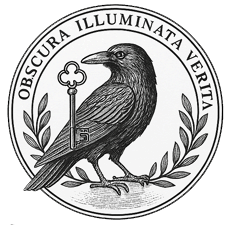Compiled Archive of Known Individuals – 1865 to 1984
Dr. Lydia StormCroft (née Glass)
Role: Founder | Aether Theorist | Architect of Project Signal
Years Active: 1865–1901
Biography & Legacy
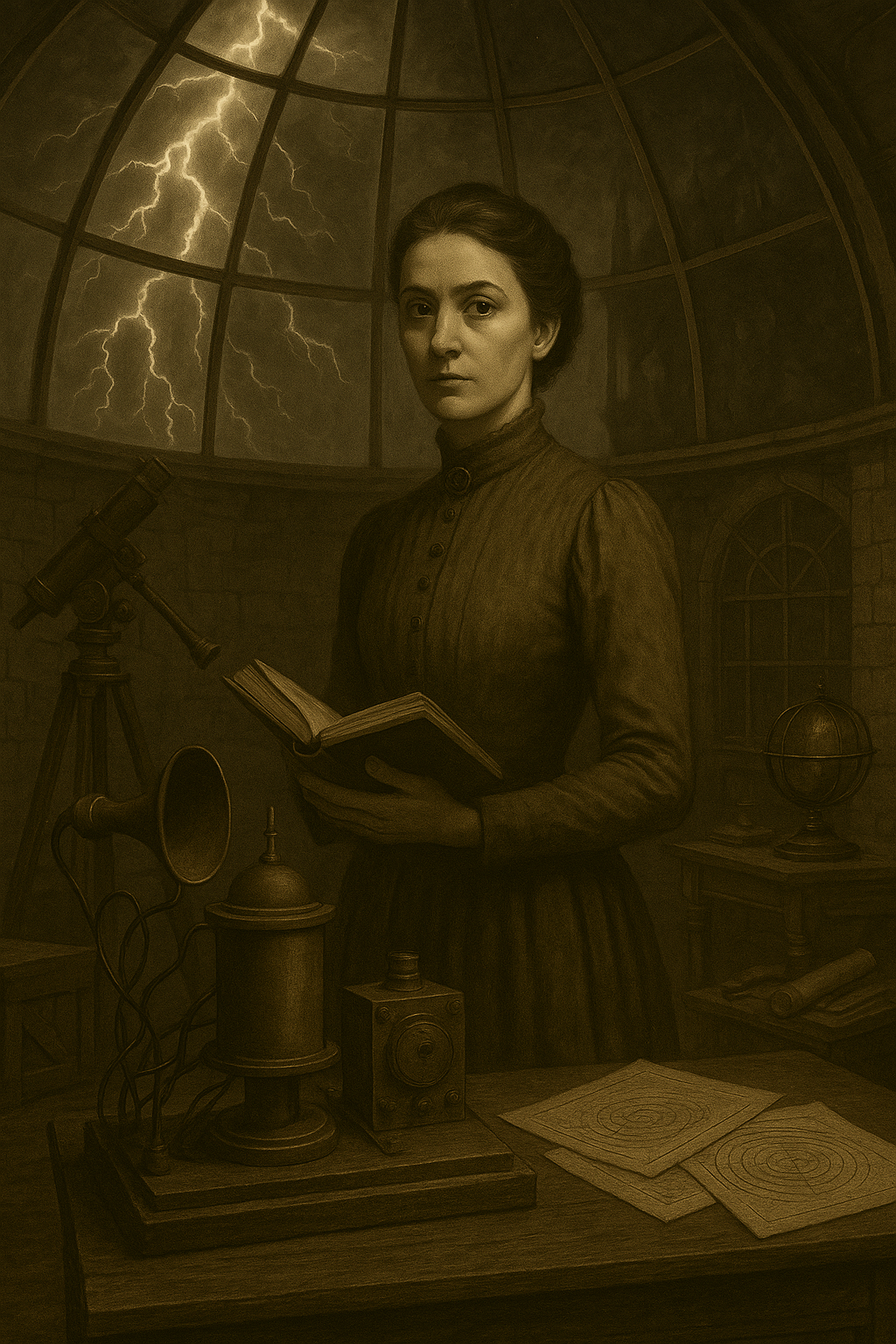
Moments before her disappearance in 1901, Dr. Lydia StormCroft stands within the resonance-aligned observatory, surrounded by aetheric instruments as lightning illuminates her final experiment—a pursuit of discovery that transcended the boundaries of space, time, and presence.
Dr. Lydia StormCroft (born Lydia Glass) stands as the intellectual cornerstone of StormCroft House’s most enigmatic and controversial work. A pioneering mind in aetheric resonance theory, Lydia was both revered and quietly feared within scientific circles for her willingness to explore the unseen forces she believed governed the interaction between environment, consciousness, and energy.
Educated privately—a necessity, given the exclusion of women from formal scientific institutions—Lydia’s early work in electromagnetic anomalies drew the attention of Octavius Wren. However, it was Lydia who provided the true foundation for StormCroft’s purpose, insisting that the house be more than a sanctuary for fringe science. To her, it was to be a conductor—a structure designed to interact with the very fabric of the unseen world.
In 1865, she co-founded StormCroft House alongside Wren but quickly became its intellectual leader, particularly in the development of Project Signal—an attempt to stabilise and harness aetheric frequencies for cognitive and environmental manipulation.
Project Signal
Under Lydia’s guidance, Project Signal sought to map the “resonant language” of the aether—believed to be the medium through which thought, memory, and physical space could be influenced.
Her theories proposed that:
-
Certain architectural designs could amplify aetheric flow.
-
Human emotions, when properly regulated (see: early forms of Regulation 7.4B), could be converted into resonant triggers.
-
The right signal could unlock both latent environmental memory and cross-temporal awareness.
While much of Project Signal remains fragmented in the archives, it’s believed that Lydia’s work laid the groundwork for later Echo Phenomena observed within StormCroft.
Disappearance
In 1901, during a violent thunderstorm, Dr. Lydia StormCroft was last seen entering the observatory dome—a structure she personally redesigned to align with her aetheric calculations.
When staff checked the dome after the storm, Lydia was gone. No signs of struggle, no exit. Only her final papers remained—written entirely in mirrored Latin, a cipher she used when recording theories too dangerous to share openly.
The last legible line read:
“Lux inter fluctus vocis—nunc respondebit.”
(The light within the waves of voice—now it will answer.)
Her body was never found. Some believe she succeeded in transcending physical space through resonance alignment. Others suspect StormCroft itself absorbed her.
Legacy
-
Lydia’s name was deliberately omitted from many formal records, replaced by references to “The Founder” or “Originator.”
-
The observatory dome was sealed in 1902, with reports of flickering lights and faint whispers persisting for decades.
-
Box 12-D contains several fragments of Lydia’s mirrored Latin notes—none fully translated.
Today, Dr. Lydia StormCroft is regarded by those who study the house’s history as both its creator and its first echo.
Her theories remain the backbone of StormCroft’s enduring anomalies, and some suggest that the house’s persistent awareness is not a side effect—but Lydia’s final, continuous experiment.
Octavius Wren
Role: Chief Engineer | Logistics Overseer | Co-Founder of StormCroft
Years Active: 1865–1890
Biography & Legacy
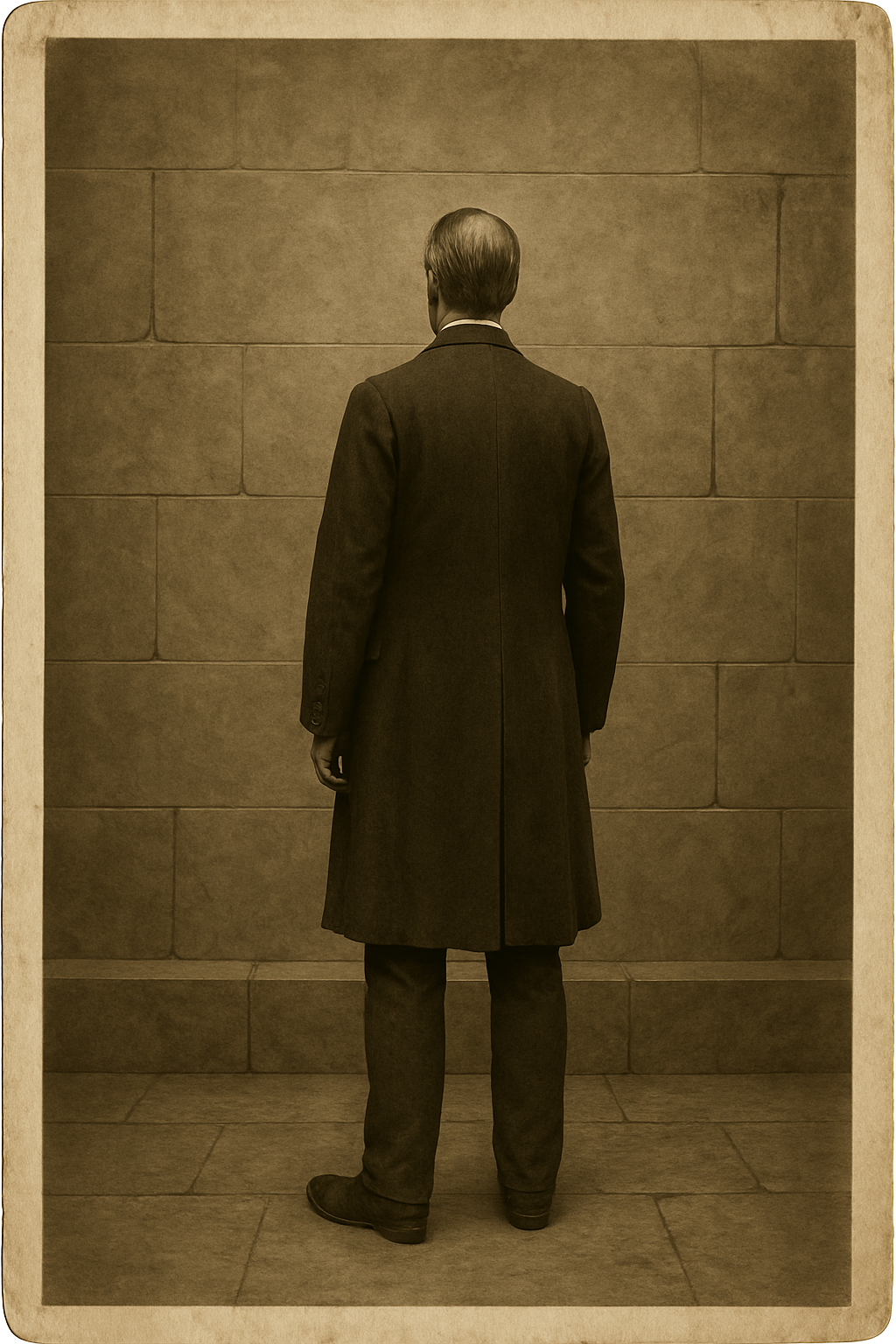
The last known photograph of Octavius Wren, captured as he faced the sealed West Vault in 1890. His posture reflects the weight of final containment—an engineer’s silent acknowledgment that StormCroft’s foundations now held more than stone and steel. Marking the end of his legacy, the image was found with the words: “No more doors.”
Octavius Wren was the practical mind behind StormCroft House—the architect not of ideas, but of possibility. Where Dr. Lydia StormCroft (née Glass) envisioned the manipulation of aetheric resonance and environmental memory, Wren ensured that her theories could be built into stone, steel, and hidden corridors.
A gifted engineer with a reputation for unconventional solutions, Wren was recruited from military logistics after designing modular fortifications that “shifted with the landscape.” His fascination with adaptable structures and concealed systems made him the ideal counterpart to Lydia’s visionary pursuits.
When construction of StormCroft began in 1865, Wren took charge of embedding experimental infrastructure beneath the façade of a Victorian manor. Secret chambers, resonance channels, echo vents, and the first shafts of what would become the Fog Spur Line were all born of his designs.
Where Lydia pursued the ethereal, Wren mastered the physical—ensuring the house could not only conduct experiments but contain them.
Key Contributions
-
The West Vault: A subterranean complex designed to store volatile equipment and suppress unstable resonance patterns. Wren was known to refer to it as “the place where the house breathes out.”
-
Fog Spur Line Foundations: While the full extent of the underground railway evolved after his time, Wren laid its initial pathways, embedding spatial irregularities into the tunnel geometry—intentionally or otherwise.
-
Adaptive Architecture: Wren implemented early versions of StormCroft’s infamous shifting layouts, using movable walls, false corridors, and resonance-triggered locks.
Disappearance & Final Act
In 1890, Octavius Wren was last seen sealing the West Vault following an undocumented containment breach. Surviving records suggest this involved a convergence of resonance anomalies tied to Project Signal remnants and early Fog Trace emissions.
When colleagues arrived hours later, Wren was gone.
All that remained was a single photograph, recovered near the sealed vault door—showing Wren standing with his back to the camera, facing the blank stone wall he had just closed. On the reverse, in his handwriting, were the words:
“No more doors.”
There is no official record of Wren’s death. Some theorise he entombed himself deliberately, believing the vault to be safer with a human anchor inside. Others suggest StormCroft absorbed him as part of its evolving structure—another element in its living blueprint.
Legacy
-
Wren’s blueprints were intentionally fragmented after his disappearance to prevent reconstruction of certain “unstable designs.”
-
His name is etched faintly into a hidden beam within the East Wing, alongside a date that doesn’t correspond to any known calendar system.
-
Modern explorers claim to hear faint metallic tapping near the West Vault foundations—always in sequences of three.
While Lydia StormCroft shaped the house’s purpose, Octavius Wren shaped its form—a form that continues to shift, adapt, and contain long after his final act.
Dr. Abram Finch
Role: Neuro-Researcher | Pioneer of Dream Resonance
Years Active: 1865–1874
Biography & Legacy
 Dr. Abram Finch was among the first scientific minds recruited by Lydia StormCroft and Octavius Wren at the founding of StormCroft House in 1865.
Dr. Abram Finch was among the first scientific minds recruited by Lydia StormCroft and Octavius Wren at the founding of StormCroft House in 1865.
A specialist in early neurophysiology and cognitive mapping, Finch was fascinated by the idea that human thought—particularly subconscious patterns—could imprint themselves onto physical environments through what he termed resonant echoes.
Finch believed that dreams were not confined to the mind but left subtle, measurable traces in surrounding space—what he called “ambient memory.”
His work was dismissed by formal academia as speculative nonsense, but at StormCroft, it became a cornerstone of early experimentation.
The Echo Table
Dr. Finch’s most ambitious creation was the Echo Table—a polished slate surface embedded with copper filigree and resonance conductors.
Subjects were instructed to sleep or enter meditative states upon the table while the apparatus “listened” for recurring emotional or cognitive frequencies.
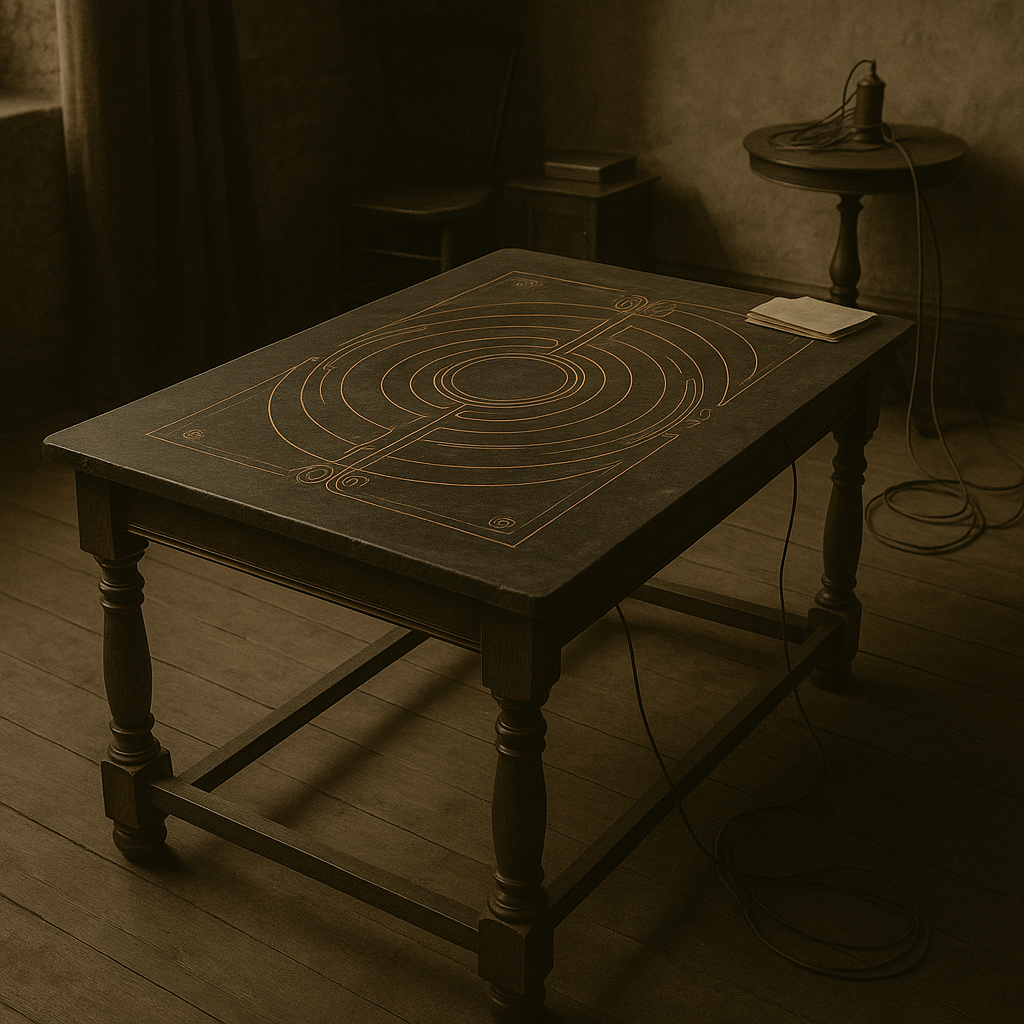
The original Echo Table, designed by Dr. Abram Finch, rests in its resonance chamber—copper filigree tracing forgotten patterns of thought. Though dormant, the table is said to still hum faintly, holding fragments of every dream it once recorded.
Initial trials claimed limited success—recording faint patterns of sound and vibration linked to recurring dreams. However, as experiments intensified, the table began to respond before subjects had even engaged, emitting low rhythmic pulses that aligned with participants’ heartbeats and breath cycles.
Finch theorised that the table had begun to store fragments of subconscious residue—a primitive form of dream imprinting.
By late 1874, concerns arose regarding prolonged exposure. Subjects reported disassociation, fragmented memories, and in some cases, episodes where they claimed to “wake up” inside rooms they had never physically entered.
Death & The Quiet Loop Phenomenon
On November 3, 1874, Dr. Abram Finch was found deceased at his writing desk, pen still in hand, mid-sentence. There were no signs of struggle or illness—his heart had simply stopped.
His final, unfinished note read:
“The table remembers before we do…”
Following his death, strange phenomena were reported in the adjacent Quiet Loop chamber, a resonance feedback room linked to the Echo Table’s output.
Technicians noted a persistent, rhythmic pulse—mirroring a human heartbeat at exactly 47 beats per minute. Analysis confirmed it matched Finch’s recorded cardiac signature from previous medical logs.
Despite dismantling parts of the Echo Table, the heartbeat continued—faint, but ever-present within the Quiet Loop.
By 1875, the chamber was sealed, with instructions never to re-engage the table’s core array.
Legacy
-
Finch’s Echo Table is considered the precursor to StormCroft’s broader Echo Phenomena research.
-
His death marked the first recorded instance of a resonant signature outliving its originator.
-
The Quiet Loop chamber remains sealed, but faint vibrations are still detectable in nearby walls—described by some as “a man patiently waiting to finish his sentence.”
Later generations of the Finch family would return to StormCroft, notably Dr. Elias Finch III, who referenced Abram’s work as “the first proof that memory has mass.”
Wilber R. Dart
Role: Railway Signal Specialist | Temporal Alignment Engineer
Years Active: 1865 – Unknown
Biography & Legacy

A rare portrait of Wilber R. Dart, StormCroft’s enigmatic railway signal engineer. Known for his pioneering work on temporal alignments within the Fog Spur Line, Dart vanished into Tunnel T-North in 1889. His precise gaze reflects both brilliance and obsession—the man who tried to control time with signals and never returned.
Wilber R. Dart was a pioneering figure in the integration of railway signalling systems with StormCroft’s most dangerous infrastructure—the Fog Spur Line. Originally contracted for standard signalling consultancy during the early construction of StormCroft’s underground passages, Dart quickly became involved in experimental modifications that pushed beyond conventional rail operations.
Dart wasn’t merely a technician; he was a visionary in his own right—obsessed with the concept that time along a railway line could be manipulated through precise signal control and engineered delays. Under the guidance of Octavius Wren, Dart developed methods to distort perceived journey durations by introducing subtle shifts in signal intervals, creating what he termed “temporal slipstreams.”
By 1870, Dart was fully embedded within StormCroft operations, tasked with managing the alignment of signals along Tunnel T-North, the most unstable and least understood section of the Fog Spur Line.
Temporal Alignment Experiments
Dart’s work focused on the theory that specific patterns of signal delay—when paired with resonant frequencies emitted from StormCroft’s underground chambers—could induce localized temporal distortions. Early test runs reported anomalies such as:
-
Journeys completed before departure times.
-
Carriages emerging aged and weathered beyond their years.
-
Passengers experiencing fragmented memories or reporting glimpses of unknown landscapes through tunnel windows.
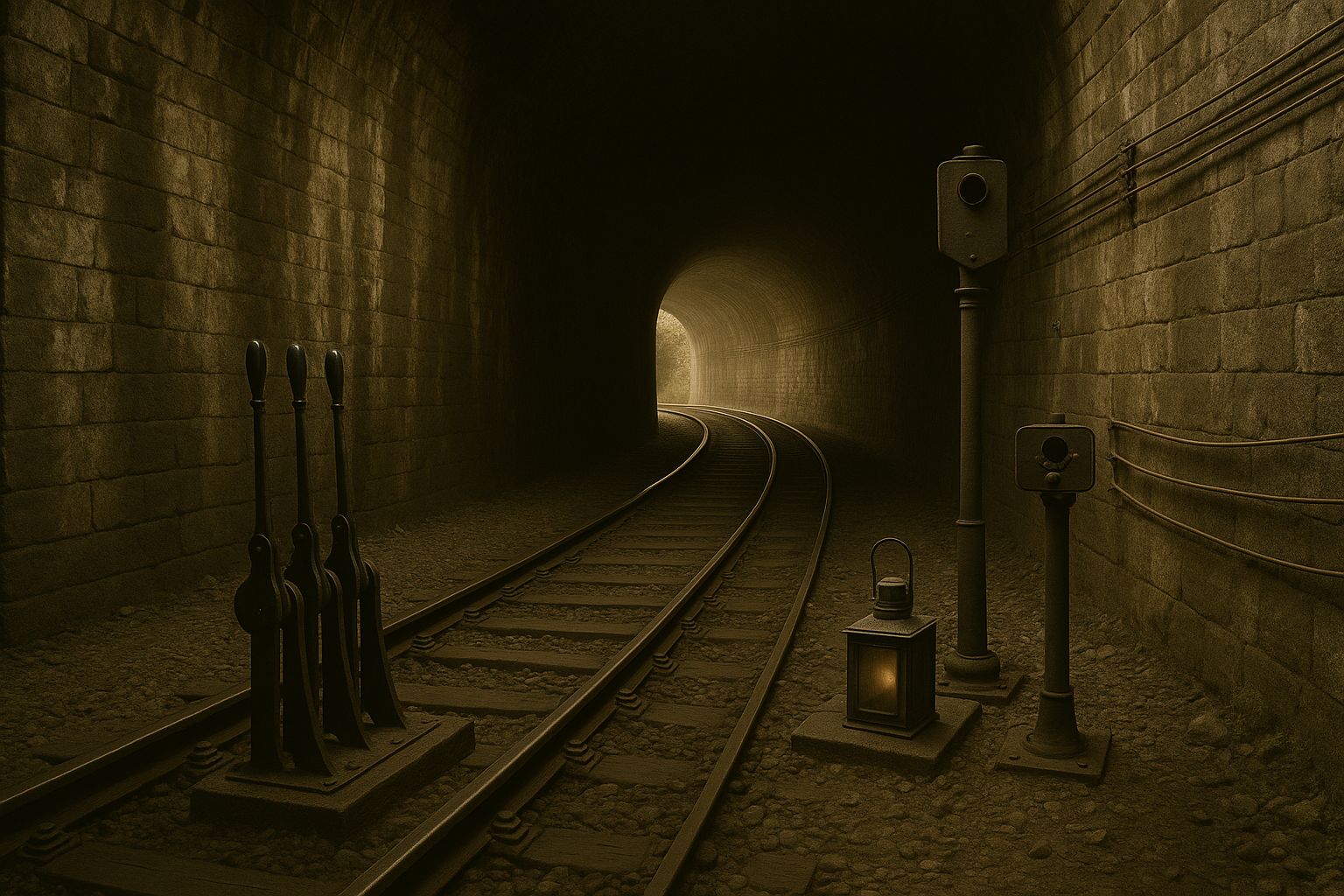
A rare view of StormCroft’s abandoned underground railway tunnel, featuring original Victorian-era signalling equipment—levers, lanterns, and telegraph wires still in place. Though silent for decades, the tunnel is said to hum faintly when unobserved, as if awaiting a journey no longer scheduled.
Rather than abandoning these dangerous outcomes, Dart became increasingly fascinated, refining the system into what internal documents referred to as the Dart Pattern—a signal sequence believed to “anchor” trains within flexible timeframes.
Disappearance
In 1889, during a solo inspection deep within Tunnel T-North, Dart vanished without trace. His last known communication was a note left at the signal control hub:
“Adjusting Pattern 4-C. If late, I’m early.”
Despite extensive searches, Dart was never recovered. Curiously, signalling equipment linked to his work continued to operate autonomously for decades after his disappearance, emitting faint pulses aligned with his custom patterns.
In 1936, following increased reports of unexplained activity within disused tunnel sections, the Transport Authority conducted a covert investigation. All documents related to Dart’s experiments and fate were redacted, with official records stating only:
“Signal irregularities resolved. No personnel outstanding.”
Unofficially, railway workers reported ongoing sightings of a solitary figure carrying a lantern deep within T-North—always seen walking against the expected direction of the tracks.
Legacy
-
The Dart Pattern remains encoded in fragments within StormCroft’s buried signal systems.
-
Tunnel T-North is still considered hazardous—not structurally, but temporally.
-
In 1974, a modern survey team recorded a faint telegraph transmission repeating:
“If late, I’m early.”—nearly 85 years after Dart’s disappearance.
Some believe Wilber R. Dart became trapped within a loop of his own creation—neither fully gone nor entirely present—walking the endless line between seconds stretched too thin.
Helen Marridge
Role: CroftNet Relay Lead | Communications Specialist
Years Active: 1969–1983
Biography & Legacy
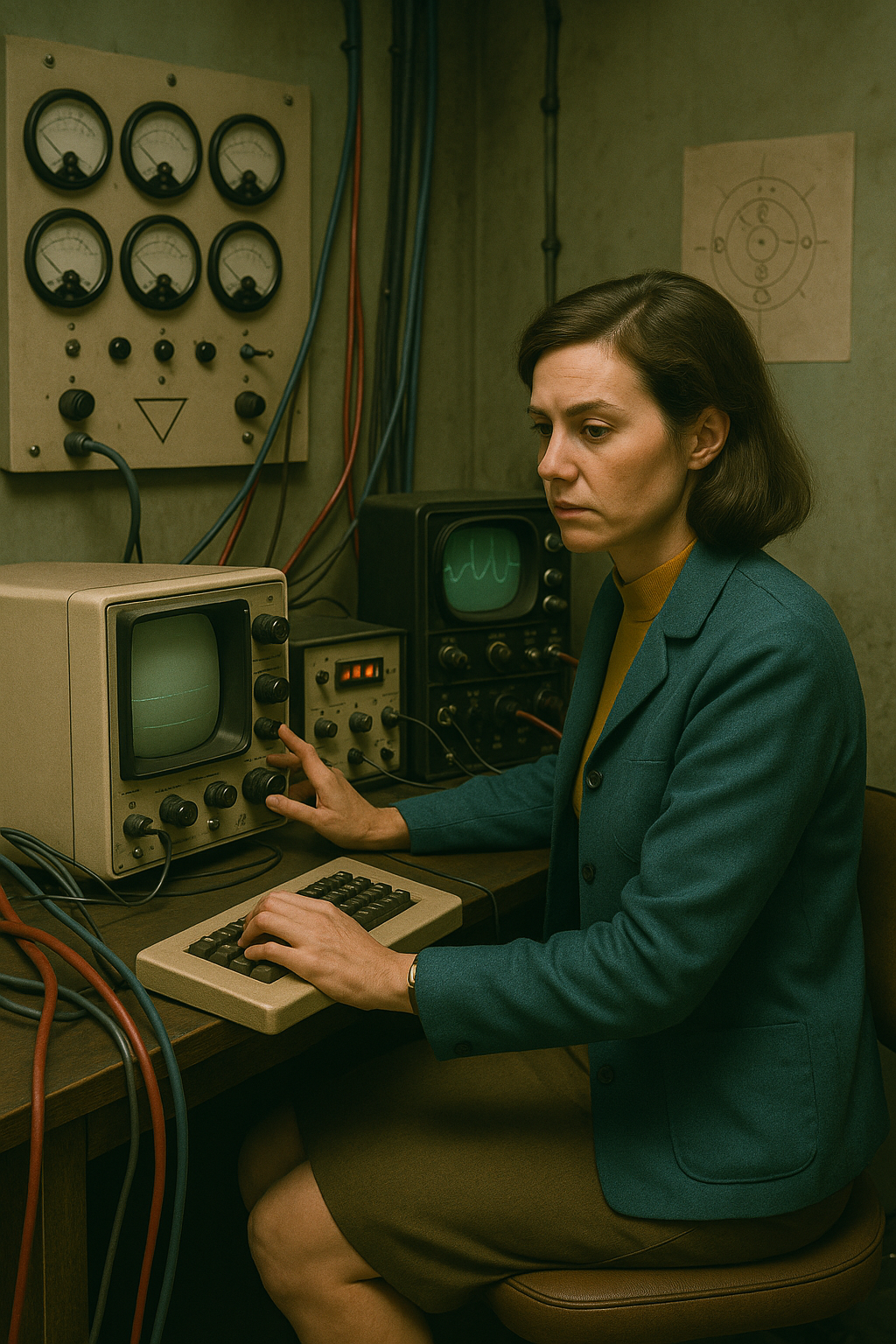
In this rare 1960s colour photograph, Helen Marridge is seen calibrating StormCroft’s experimental CroftNet relay system. Surrounded by hybrid analogue-digital equipment, Marridge worked tirelessly to stabilise resonance signals—unaware that her final transmission to Black Room Delta would mark both the collapse of CroftNet and her untimely death.
Helen Marridge was a communications engineer brought into StormCroft during its final operational phase in the late 20th century. Recruited for her expertise in experimental networking and signal distribution, Marridge became the lead architect behind CroftNet—a closed-loop internal relay system designed to manage and contain the increasingly unstable resonance phenomena within the estate.
By the late 1960s, traditional methods of monitoring StormCroft’s anomalies—manual logs, physical observation, and analogue devices—were proving insufficient. CroftNet was conceived as a hybrid system, combining early digital relay nodes with the house’s legacy resonance infrastructure. It wasn’t just a communications network; it was designed to “listen” to the house’s patterns and provide predictive warnings when environmental or temporal distortions escalated.
Marridge quickly rose to prominence within the dwindling Finch Committee for her ability to stabilise key nodes and expand CroftNet’s reach into previously unmonitored sectors, including sealed chambers and deep tunnel systems.
The Black Room Delta Incident
In 1983, Helen initiated a test signal to a previously dormant sector known as Black Room Delta—an off-grid chamber believed to house remnants of early Finch and Wren experiments. The objective was simple: establish a one-way data relay to map residual energy patterns.
Initial reports indicated no response. For 17 minutes, CroftNet registered complete silence—expected for a dead zone.
At minute 18, everything changed.
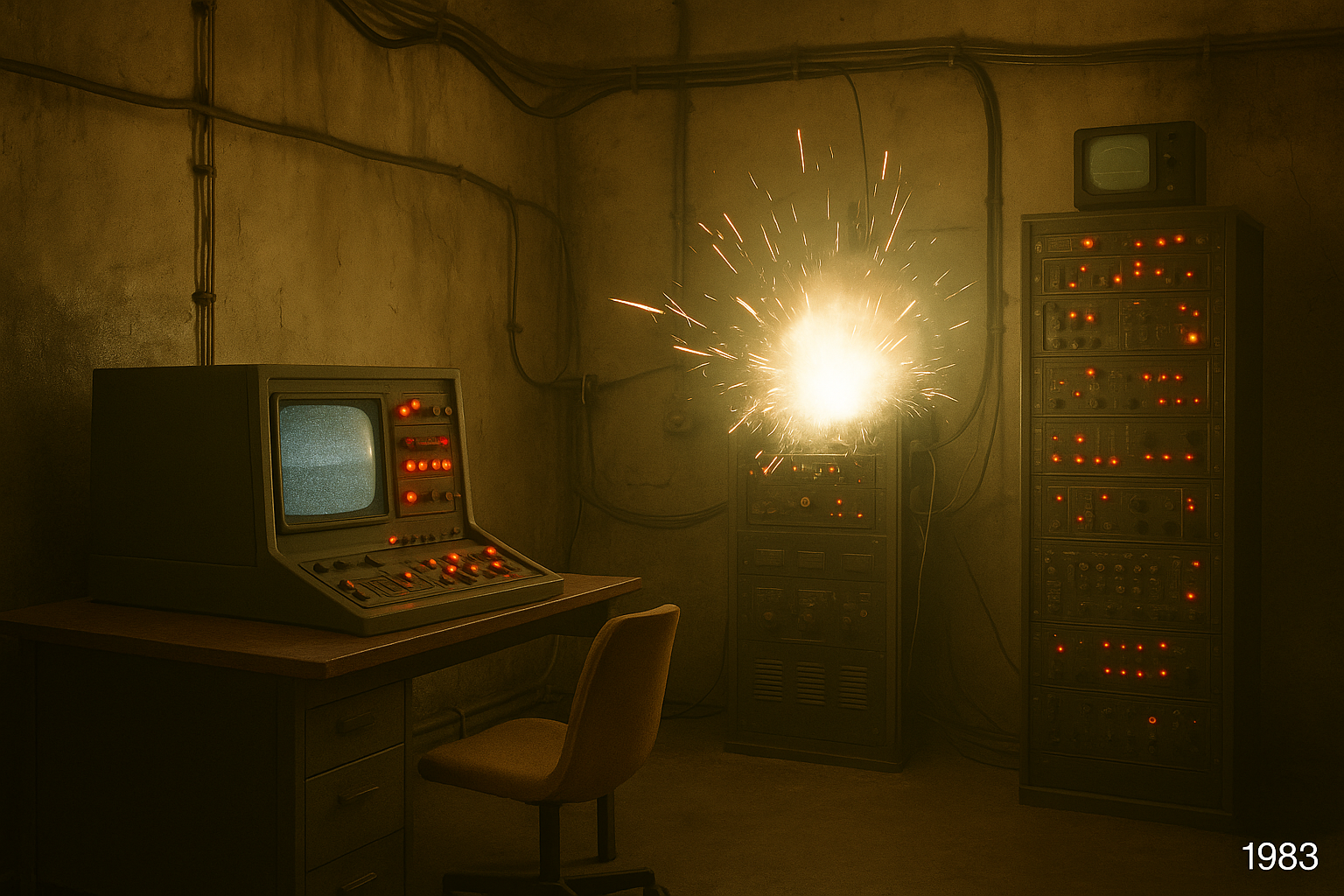
A rare image capturing the moment CroftNet systems overloaded during Helen Marridge’s fatal transmission. The dim control room, filled with flickering monitors and tangled cables, became the epicentre of uncontrolled resonance feedback—marking the point when StormCroft’s legacy of suppressed science surged beyond human control.
According to surviving logs, a sudden flood of data—far exceeding the network’s capacity—was transmitted back through the relay. The content of this transmission remains classified, but it’s known that multiple nodes across CroftNet overloaded simultaneously, causing system-wide failures and unexplained environmental surges throughout StormCroft.
Helen Marridge collapsed at her workstation during the event—suffering what was described as “neurological shock consistent with prolonged sensory overload.” She was declared dead within the hour.
Her final handwritten note, found beside the terminal, read:
“No response. Then too much.”
Legacy
-
After Helen’s death, all access to Black Room Delta was permanently severed. The room’s location was erased from surviving maps.
-
CroftNet was partially decommissioned, leaving only passive nodes operational until the house’s closure in 1984.
-
Marridge is considered the last technical lead to attempt full integration between modern systems and StormCroft’s legacy resonance fields.
In the years since, fragments of CroftNet’s corrupted data packets have been detected by independent researchers—often containing incomplete phrases, distorted coordinates, and repeating patterns resembling Helen’s own voice.
Some believe that when Helen opened a channel to Black Room Delta, she didn’t just receive data—she connected to something that had been waiting far longer than anyone realised.
Edwin “Ned” Thorne
Role: Domestic Servant | Witness to Founding Rituals
Years Active: 1876–1881
Biography & Legacy
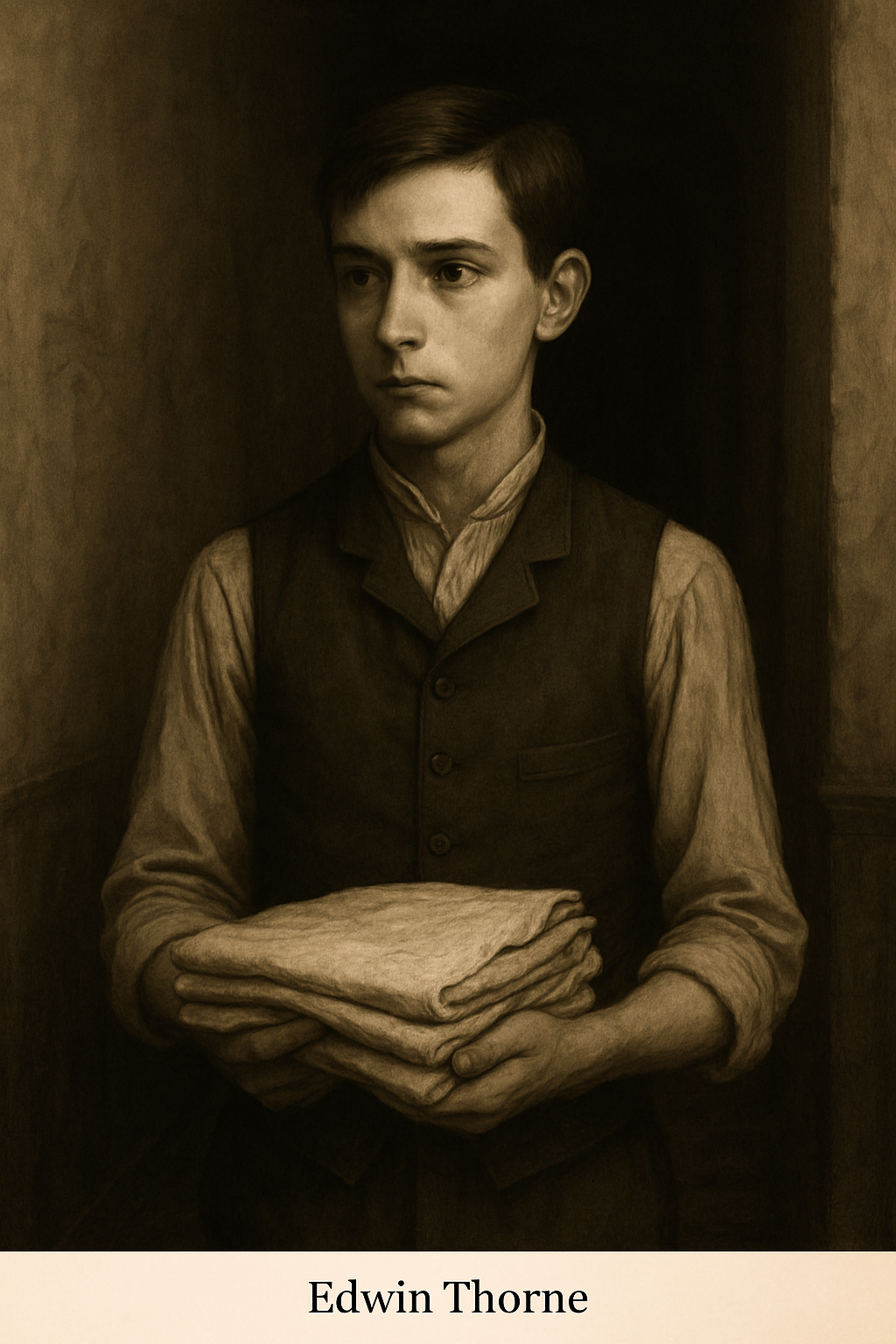
A portrait of Ned Thorne at age 17, captured during his later years at StormCroft. His modest servant attire and wary expression reflect a youth shaped by more than routine duties—bearing silent witness to the house’s hidden rituals and the subtle distortions creeping into daily life.
Edwin “Ned” Thorne was a young domestic servant recruited into StormCroft House at the age of 14 during one of its most volatile periods. Active between 1876 and 1881, Ned was among the few non-specialist staff to survive prolonged exposure to the house’s early experimental phase—particularly during the era when Dr. Lydia StormCroft, Octavius Wren, and Dr. Abram Finch conducted unregulated resonance practices.
Originally assigned mundane duties—cleaning, linen management, and attending to servant quarters—Ned was gradually drawn into more obscure roles, often referred to in fragmented records as “ritual maintenance” and “pattern observance.”
Witness to the Founding Triad
In 1949, decades after leaving StormCroft, Ned—then an elderly man—was interviewed by an anonymous researcher compiling oral histories about the estate.
Despite failing eyesight and bouts of confusion, Ned vividly described what he called the “intimate rituals” conducted by the founding triad (Lydia, Wren, and Finch). According to his account, these rituals weren’t ceremonial in a traditional sense but involved:
-
Precise spatial movements within marked rooms.
-
The folding and placement of specific fabrics, garments, and objects—believed to influence resonance flow.
-
Periods of synchronized silence, where the trio would remain motionless, allowing the house to “adjust” around them.
-
Ned’s role was often to reset these arrangements—refolding linens, repositioning items, and ensuring no unintended “creases” in spatial alignment.
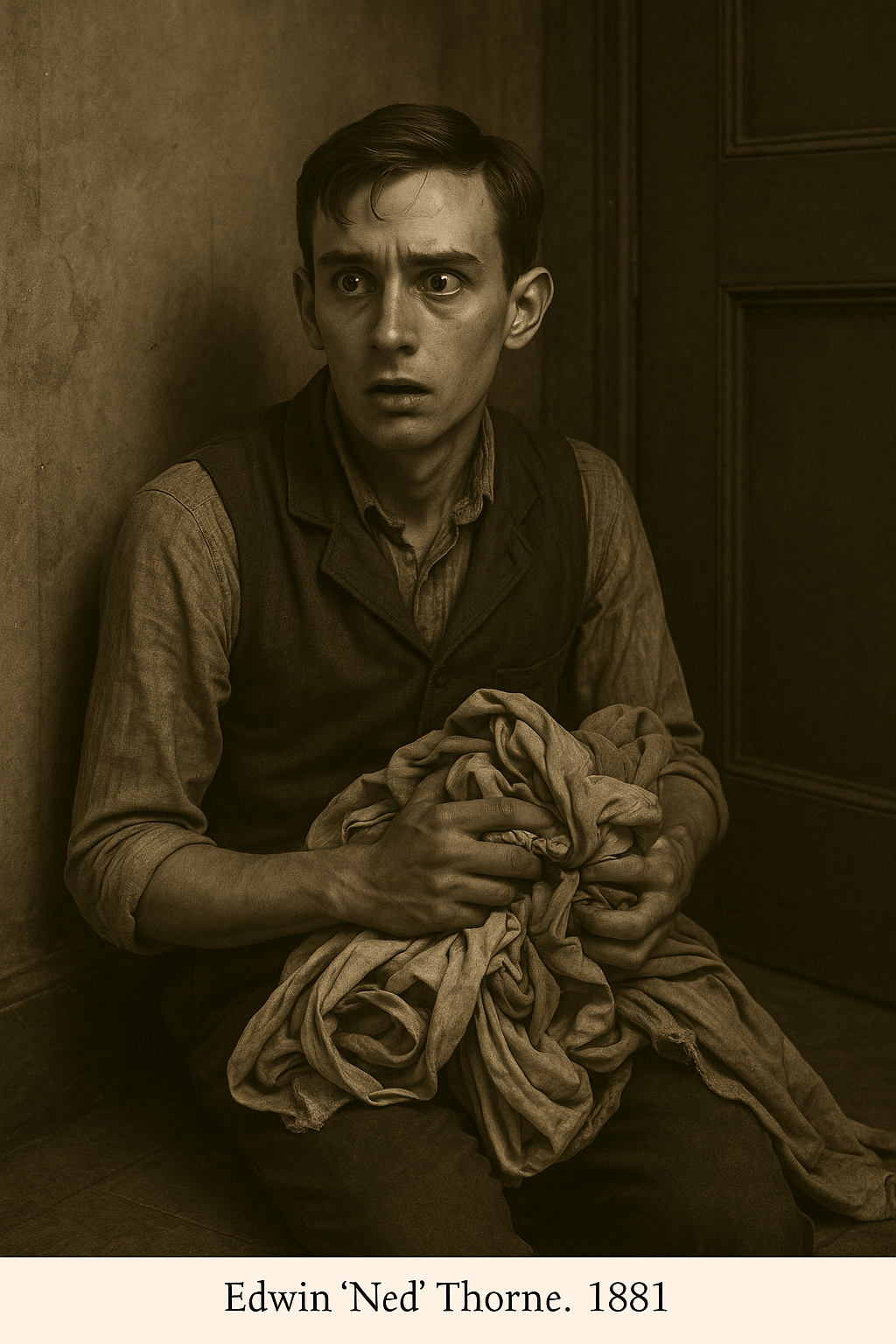
Captured moments after the undocumented “Fold Inversion” incident, Ned Thorne appears disoriented amidst distorted linens and warped surroundings. His haunted expression reflects the unseen rupture within StormCroft’s delicate spatial rituals—an event that forced his abrupt departure and echoed in his fractured memories for the rest of his life.
He claimed that mistakes in these patterns would result in subtle but disturbing shifts—doors no longer leading where they should, reflections showing delayed movements, and sounds repeating hours after they were first made.
Departure and Decline
Ned left StormCroft abruptly in 1881 after an undocumented incident, which he later referred to only as “the fold inversion.”
Over the following decades, Ned lived a reclusive life in Devon. By the 1930s, he had gone completely blind, though no medical cause was ever confirmed. Locals reported hearing him muttering cryptic phrases, the most frequent being:
“We folded wrong…”
“Corners where there should be curves…”
“They’re still standing where I left them…”
His 1949 interview was the last known contact he had with anyone connected to StormCroft. Ned died shortly after, clutching what appeared to be a perfectly folded cloth—despite his blindness.
Legacy
-
Ned Thorne is regarded as one of the few living witnesses to the private behaviours of StormCroft’s founders.
-
His descriptions contributed to later theories about resonance-triggered domestic patterns—the idea that simple servant routines (folding, placement, cleaning) were integral to maintaining spatial stability within the house.
-
The cloth found at his death was later examined and found to contain impossible folds—angles and overlaps that defied replication once unfolded.
Some believe Ned wasn’t merely a servant but an unknowing participant in StormCroft’s early environmental conditioning—his tasks quietly sustaining the house’s delicate balance.
Peter Winch
Role: Records Archivist | Temporal Anomaly Analyst
Years Active: 1946–1954
Biography & Legacy
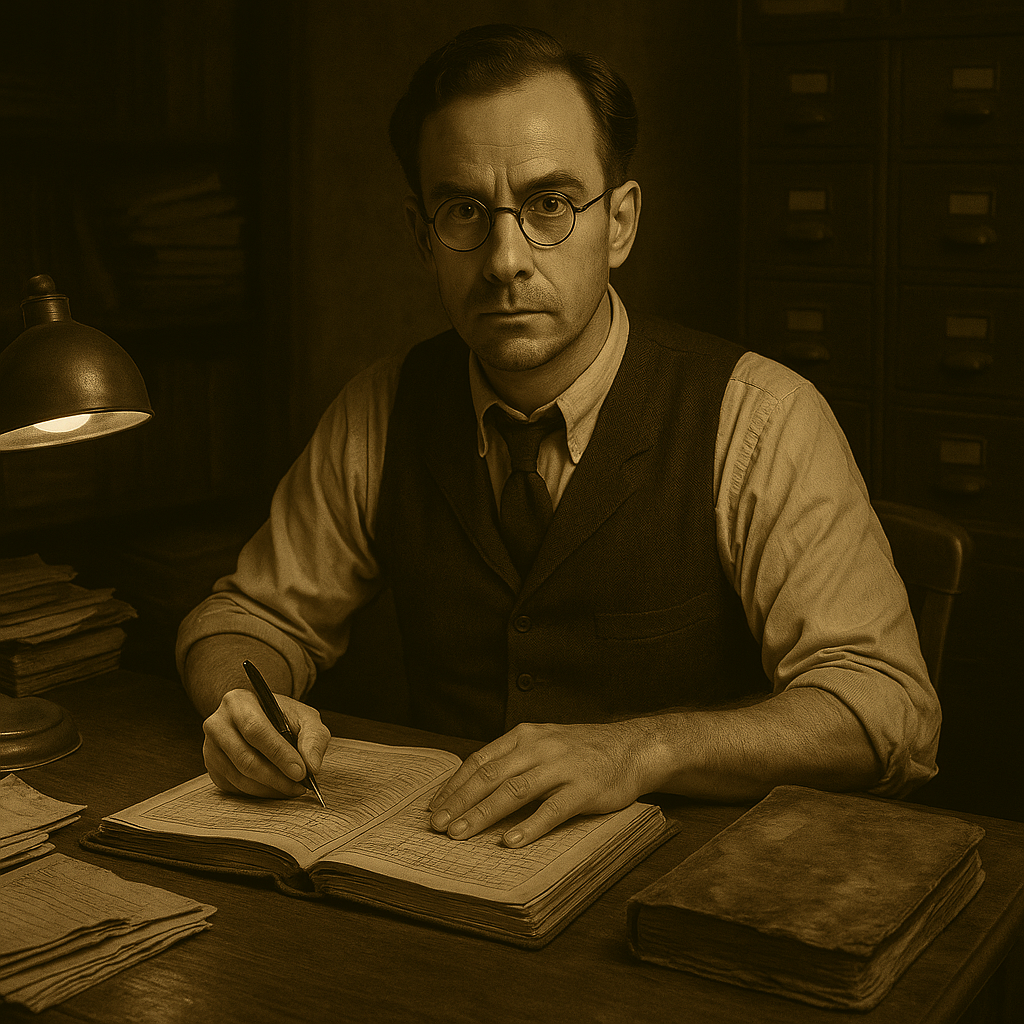
A rare photograph of Records Archivist Peter Winch, deep in analysis within StormCroft’s west wing archives. Surrounded by aging documents and the infamous water-damaged ledger, Winch unknowingly approached the threshold of discovery that would erase him from time—leaving only pages that continue to rewrite themselves in his absence.
Peter Winch was a meticulous and introverted Records Archivist assigned to StormCroft House in the aftermath of World War II, during a period when the estate’s operations had shifted from active experimentation to cautious containment and documentation.
Hired in 1946 by the remnants of the Finch Committee, Winch’s primary task was to organise decades of fragmented logs, experimental notes, and sealed protocols—many of which had been deliberately obscured by earlier generations. Known for his obsessive attention to detail, Peter soon became one of the few individuals to recognise recurring patterns hidden within disparate records.
It was during his deep archival work that Peter began to notice references to a phenomenon labelled “Loop Bleed” — a term absent from official glossaries but scattered across handwritten margins, redacted documents, and faded annotations dating back to the late 19th century.
By 1953, Winch had compiled enough cross-referenced material to theorise that StormCroft’s resonance events were not isolated incidents but part of a continuous temporal distortion—what he termed:
“Loop bleed across basal time.”
This phrase suggested that certain actions, memories, or environmental states within StormCroft weren’t merely echoing—they were leaking into foundational layers of time itself, subtly rewriting the present by allowing fragments of past anomalies to persist and evolve.
Disappearance
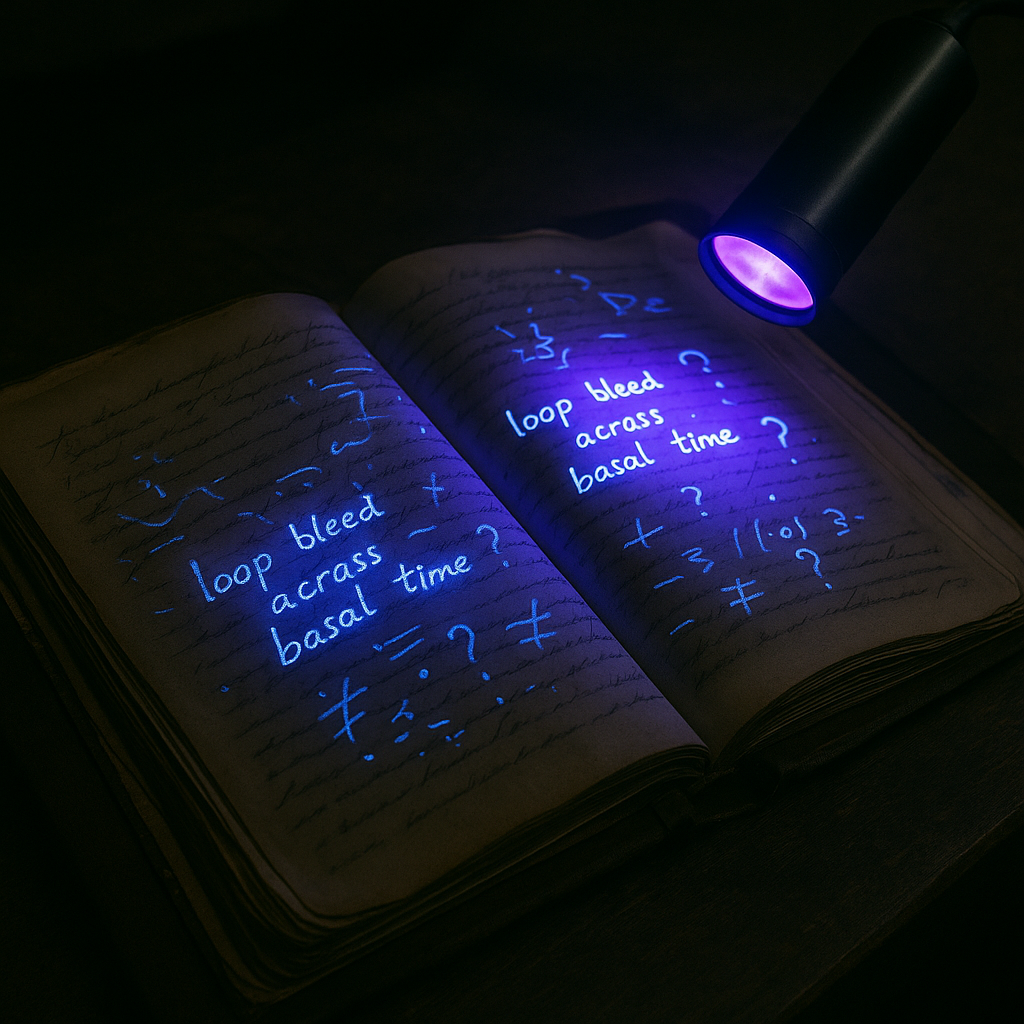
The water-damaged ledger left behind by Peter Winch reveals its true nature under UV light—shifting text, fragmented phrases, and cryptic symbols endlessly rewriting themselves. A living document, it holds the only trace of StormCroft’s “loop bleed across basal time.”
In early 1954, Peter Winch submitted a partial report outlining his findings. Days later, he vanished without a trace. His quarters were undisturbed, his belongings intact—except for a single water-damaged ledger left open on his desk.
The ledger was initially dismissed as ruined, its ink blurred and pages warped. However, when exposed to ultraviolet light during a routine inspection, the pages revealed something extraordinary:
-
The text was rewriting itself—lines appearing, shifting, and fading in real time.
-
The content included fragmented sentences, timestamps that didn’t align with known calendars, and repetitions of Peter’s own handwriting—despite his absence.
Notably, the phrase “loop bleed across basal time” appeared and reappeared throughout the ledger, often accompanied by sketches of impossible geometries and references to rooms that no longer existed within StormCroft.
Attempts to remove or destroy the ledger failed. When relocated, it was found back in its original position within hours—always damp, always active under UV light.
Legacy
-
The Winch Ledger remains one of StormCroft’s most enigmatic artifacts, now stored in a sealed archive room beneath the west wing.
-
Modern researchers describe the ledger as “alive in context”—reacting only within StormCroft’s boundaries.
-
Peter Winch’s disappearance is officially recorded as “voluntary departure,” though no evidence supports this claim.
Some believe Peter succeeded in mapping the bleed long enough to become part of it—his existence folded into the very anomalies he sought to understand.
Rumours persist that, on rare occasions, fresh entries appear in the ledger signed simply:
“—P.W.”
Maureen Giddens
Role: Housekeeper and Herbalist
Years Active: 1872–1879
Biography:
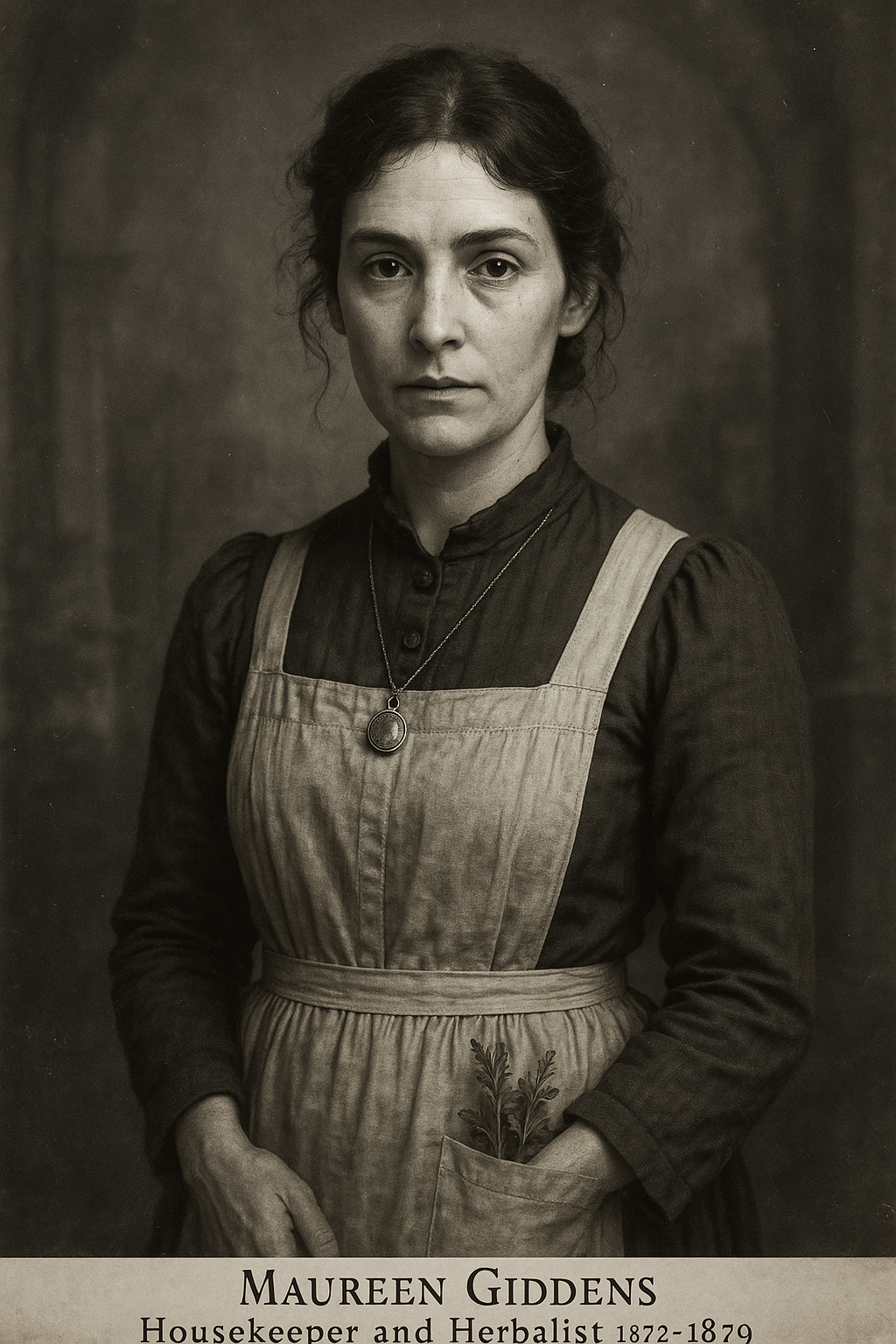
A rare staff portrait of Maureen Giddens, renowned for her dual role as StormCroft House’s Housekeeper and clandestine Herbalist. Captured circa 1875, the image reflects her calm authority and enigmatic presence. Notable are the sprigs of herbs tucked into her apron—a subtle nod to her controversial botanical practices, which were later banned following reports of auditory hallucinations. Giddens remains a pivotal figure in StormCroft’s history, remembered for her influence over both the household and its more esoteric experiments.
Born in 1844 in the remote village of Kington, Herefordshire, Maureen Giddens was the youngest daughter in a long line of herbalists, midwives, and practitioners of folk magic. Raised amidst ancient woodland and folklore, Maureen inherited not just botanical knowledge but a deep-seated belief in the spiritual consciousness of nature. By her late twenties, she was known locally as a “quiet witch,” respected for her remedies and feared for her whispered connections to the unseen.
In 1872, at the age of 28, Maureen was discreetly recruited by Dr. Octavius Finch following a chance encounter at a private herbalist gathering in Shropshire. Finch, intrigued by her intuitive grasp of plant properties and their effects on cognition, offered her a position at StormCroft House—a place where the lines between science, the occult, and experimental psychology were deliberately blurred.
Key Responsibilities:
-
Custodian of the West Wing:
Tasked with maintaining the West Wing, an area infamous for ambient distortions, temporal slips, and heightened echo activity. Maureen was uniquely untroubled by these phenomena, claiming her herbal wards “kept the house in conversation, not conflict.” -
Herbalist-in-Residence:
Created tinctures, teas, and smoke infusions designed to soothe, stimulate, or expand consciousness. Many of her blends were unofficial, operating in the grey space between accepted medicine and esoteric experimentation. -
Carer to Dr. Finch:
After Dr. Finch’s collapse in 1873, Maureen became his primary attendant, using her knowledge of sedatives and mind-expanding herbs to manage his fluctuating mental state. Some believed she drew Finch deeper into dream states under the guise of healing, fostering his obsession with “veil breaches” and cognitive exploration. -
Mandrake Cultivation:
In the south conservatory, Maureen cultivated mandrake, belladonna, and other psychotropic flora. Her focus was on “dream-guiding plants,” which she believed allowed controlled passage into echo realms—dimensions touched by StormCroft’s experiments.
The Hallucination Incident & Herbal Ban (1876):
Maureen’s influence grew quietly until 1876, when reports of widespread auditory hallucinations among staff triggered alarm. Servants described:
-
Hearing their names whispered by unseen voices.
-
Prolonged periods of disassociation.
-
Sleepwalking into restricted areas guided by “familiar but impossible” sounds.
Investigations led by Samuel Rooke identified Maureen’s herbal infusions—specifically those burned in communal spaces—as the catalyst. The combination of her botanicals with residual Fog Trace particles within the house was found to amplify echo phenomena unpredictably.
Under pressure, Dr. Finch reluctantly banned all of Maureen’s herbal preparations, though he continued to request private tinctures for his own use.
Connection to Fog Transport:
Maureen’s methods caught the attention of early Fog Transport operatives. In 1875, she was approached by Octavius Wren, who saw potential in using her botanical compounds to stabilise subjects undergoing transport experiments. Maureen developed a “veil-dampening elixir”, intended to anchor cognitive function during brief exposures to Fog pathways.
However, the elixir produced mixed results—while it reduced immediate psychological distress, it also induced long-term dream entanglement, where subjects reported continuous shared dreams involving StormCroft imagery, regardless of their physical location.
Wren terminated the trials, but Maureen retained a private interest in Fog phenomena, believing that her plants could one day allow safe navigation through Fog Traces without mechanical intervention.
Personal Relationships & Scandal:
Despite her enigmatic presence, Maureen formed close bonds with several younger staff members, often taking on a mentor role, especially with those vulnerable to the mental strains of StormCroft life.
Relationship with Samuel Rooke:
-
Samuel admired Maureen’s precision and her belief that materials carried memory—a philosophy aligned with his own theories on linen lore.
-
The two exchanged encoded notes, blending herbal symbols with numerological patterns.
-
Rooke later wrote that Maureen was “the only person who could fold silence into a sachet.”
Bond with Edwin Merle:
-
Maureen showed a protective affection for Edwin Merle, who, at just 17, was exposed to dangerous levels of echo resonance.
-
She crafted personal wards for Edwin, stitched discreetly into his linens, and prepared calming brews to ease his post-Chamber tremors.
-
Edwin referred to her in later notes as “Mother Mandrake,” though there’s no evidence of a maternal relationship beyond care and guidance.
The Pregnancy (1878):
By the early months of 1878, a quiet but persistent whisper began threading its way through the corridors of StormCroft House—Maureen Giddens, the enigmatic Housekeeper and Herbalist, was rumoured to be with child. In a household where secrets were currency, this revelation carried the weight not only of scandal but of something far more orchestrated and unsettling.
For those few who had access to Dr. Finch’s private papers, it was clear that Maureen’s pregnancy was no mere lapse in propriety. It was part of a deliberate, unsanctioned experiment—an attempt to craft life influenced by hereditary resilience, cognitive potential, and the peculiar energies that permeated StormCroft.
Jonathan Hales: The First Candidate
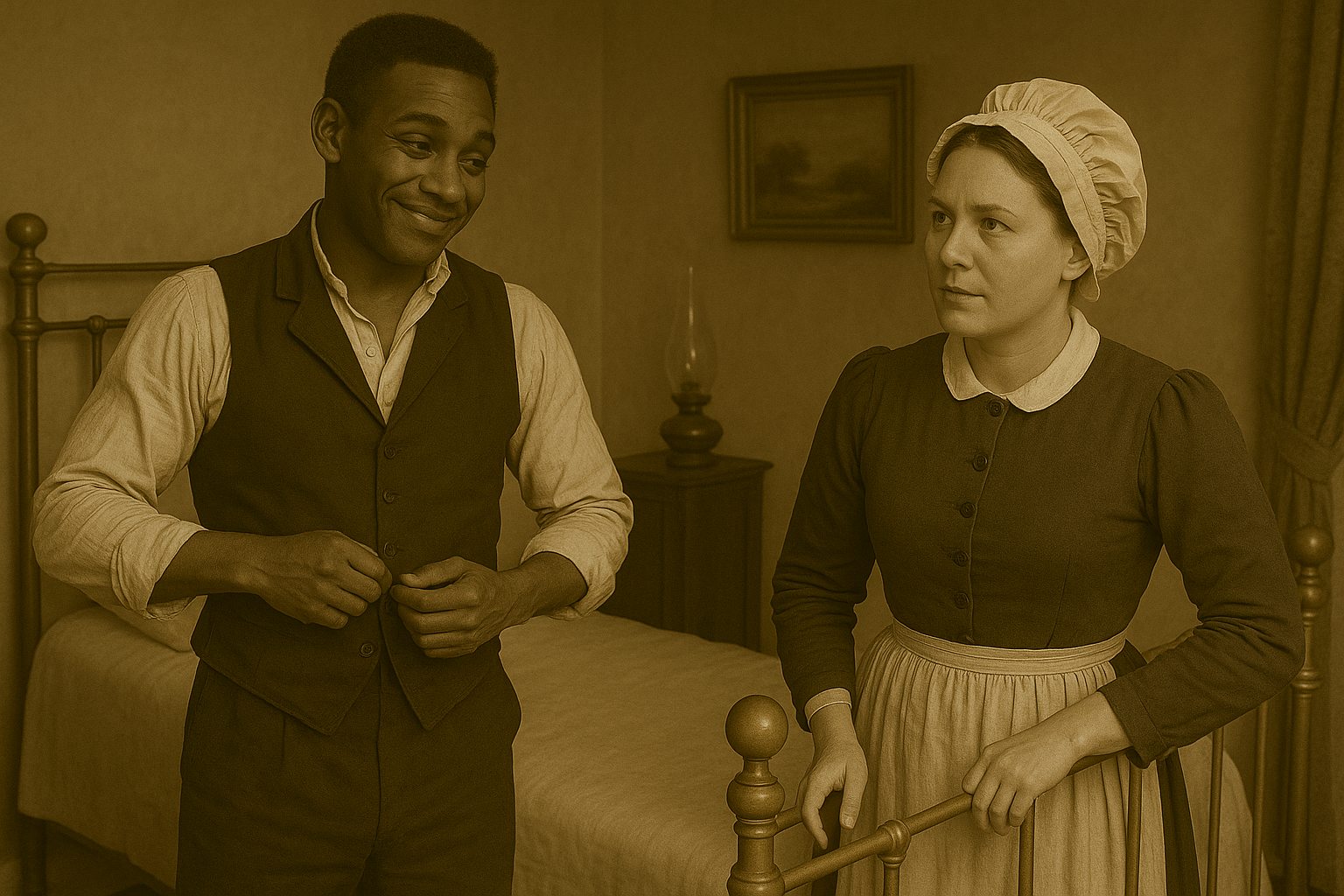
Captured in a quiet chamber of StormCroft House, this evocative scene shows Jonathan Hales, a young kitchen porter, and Maureen Giddens, the housekeeper and herbalist, in a moment of restrained tension. Maureen’s expression reveals a mix of contemplation and resolve, while Jonathan offers a nervous smile, betraying his discomfort beneath a cloak of youthful confidence. Set during the final of three failed conception attempts, this image reflects the quiet burden of their roles within a broader, unspoken experiment—one that blurred the boundaries of duty, science, and personal agency within the walls of StormCroft.
The initial efforts to conceive were not left to chance nor affection. Jonathan Hales, then only 18 years old, was selected for reasons far removed from emotion. His youth, robust health, and, as Finch clinically recorded, an “exceptional reproductive profile” made him an ideal candidate in the eyes of StormCroft’s senior minds.
There was, however, a more delicate detail noted in Finch’s private observations—a characteristic unspoken in public but well-known among the servants: Jonathan’s physical endowment was unusually large for his age, a fact that had drawn both idle gossip and quiet fascination within the servant quarters.
In the context of Finch’s theories, this anatomical trait was seen not as trivial curiosity but as a signifier of vital force—a supposed indicator of fertility potency.
What followed were three orchestrated encounters between Jonathan and Maureen, conducted under a veneer of clinical detachment but marred by the physical realities of the arrangement.
Despite Maureen’s stoic demeanour and willingness to endure for the sake of what she viewed as a higher purpose, records—particularly a veiled entry in Samuel Rooke’s encrypted journal—indicate that these attempts caused her notable discomfort, even pain:
“The union, though necessary, proved ungainly. The boy’s measure—more burden than blessing—brought her to the edge of endurance. After the third trial, she walked as though bearing echoes not yet conceived.”
Maureen, ever pragmatic, pressed on, but Jonathan grew increasingly unsettled—not only by the clinical coldness of the act but by the visible strain it placed upon her. The combination of physical discomfort, emotional detachment, and Jonathan’s growing sense of violation led him to withdraw from further participation before a fourth attempt could be arranged.
Finch, recognising both the psychological and physiological toll on both parties, abandoned the initial plan.
Thane Merrow: The Unscripted Conception

Set in the hush of the StormCroft conservatory, this moment captures a quiet exchange between Thane Merrow, the thoughtful Bath Steward, and Maureen Giddens, the housekeeper and herbalist whose influence touched both the physical and the metaphysical currents of the house. Their bond—born of shared philosophies and mutual respect—stood in contrast to earlier, failed efforts of forced conception. In time, it was Thane, with his calm presence and natural compatibility, who succeeded where intervention had failed, allowing life to emerge not through control, but through trust and alignment of intent. Their child remains one of StormCroft’s most whispered legacies.
It was within this failure that nature, unbound by design, took its own course. Later that same year, Maureen conceived—not through calculated intervention, but through a genuine, if discreet, union with Thane Merrow, the 24-year-old Bath Steward.
Unlike the sterile arrangements with Jonathan, Maureen’s connection with Thane emerged from shared philosophy, long hours spent in quiet collaboration over infusions, and a mutual belief in the memory of water and root. Their relationship, while conducted in secrecy, was marked by a natural compatibility absent from the earlier trials.
When Maureen’s condition became undeniable in late 1878, only a trusted few—Finch, Rooke, and perhaps Edwin Merle—were aware of the full story: that StormCroft’s intended experiment had failed by force, only to succeed by fate.
Concealment and Departure:
Throughout 1879, Maureen carefully concealed her pregnancy, aided by her senior position and isolation within the West Wing and conservatory. By the year’s end, she quietly departed StormCroft, her figure cloaked both in heavy garments and the silence of those who respected her legacy.
No formal record of the child exists. Yet, tucked away in Box 7-F of the Echo Risk Register, a cryptic annotation lingers:
“One root taken, watered beyond these walls. Legacy uncertain.”
Reflections and Legacy:
Jonathan Hales never spoke of his involvement. Those close to him noted a subtle shift in his character—a deepened introspection and a cautious distance from the more experimental demands of StormCroft life thereafter. Rooke, ever the observer, hinted in his writings at a lingering guilt shared between them:
“Some echoes are born not of sound, but of touch ill-placed by duty.”
As for Maureen, her departure marked the end of StormCroft’s most intimate attempt at blending biology, botany, and esoteric design. Whether her child carried forward the intended legacy—of memory through blood and root—remains a question unanswered.
Rumours persisted for decades of a child attuned to the unseen, a figure who may have later crossed paths with Fog Transport circles. But as with many things in StormCroft’s shadowed history, truth and speculation remain entwined.
Departure and Legacy:
Maureen’s exit marked the end of StormCroft’s most experimental use of botanical dreamwork. Her conservatory was sealed, and staff were forbidden from using herbal methods without explicit approval.
Yet, her influence lingered:
-
Residual Effects: Rooms once under her care continued to exhibit olfactory echoes—the scent of crushed herbs or mandrake despite decades passing.
-
The Whispering Conservatory: Attempts to repurpose the space failed due to persistent plant regrowth of unknown origin.
-
Fog Transport References: Later documents suggest that a Giddens Protocol—a method for calming Fog-exposed subjects—was adapted from her early elixir recipes, though stripped of psychotropic elements.
Notable Traits & Beliefs:
-
Botanical Sentience:
Maureen maintained that certain plants were not only sentient but actively participating in StormCroft’s experiments. -
Dream as Passage:
She believed dreams were not illusions but realms—and that StormCroft was a beacon within them, attracting entities and memories alike. -
Protective Craft:
Her herbal wards became prized by servants, with some risking punishment to keep them hidden after the ban.
Unresolved Mysteries:
-
The fate of Maureen’s child, presumed born in late 1879. Some theorists suggest a descendant later became involved in 20th-century Fog Transport projects.
-
Reports of “The Mandrake Woman”—a spectral figure seen near the West Wing in the early 1900s, accompanied by the scent of sage and soil.
-
A sealed linen pouch, marked with both Giddens’ and Rooke’s sigils, remains unopened in Box 12-D, classified under Echo Hazard – Cognitive.
Simon Vallentine
Role: Bell Room Technician
Years Active: 1910–1922
Biography:

A formal sepia-toned studio portrait of Simon Vallentine at age 21, taken in 1913. Seated in a classic pose, Simon wears a three-piece suit typical of the Edwardian era, his expression composed and thoughtful. The image captures the poise and promise of a young man on the brink of adulthood, just before the world was changed by war.
Born in 1887 in Marlborough, Wiltshire, Simon Vallentine displayed an early fascination with mechanical harmonics and resonance phenomena—an unusual passion noted during his schooling, where he became known for crafting rudimentary musical instruments out of wire, glass, and timber. His intuitive understanding of soundwave manipulation caught the attention of recruiters connected to the lesser-known experimental wings of StormCroft operations, and he was brought into service at the house in 1910 at the age of 23.
Simon was assigned to one of the most obscure and dangerous areas of StormCroft: the Bell Room—a chamber housing the Aether Bell, a device constructed in the late 19th century to investigate dimensional resonance, time distortion, and cognitive echoes.
Key Responsibilities:
-
Resonance Adjustments:
Simon was tasked with fine-tuning the Aether Bell’s frequency output, a task requiring extreme precision. Minor miscalculations could (and did) result in localized distortions, loss of linear time perception, and intense emotional disturbances among nearby personnel. -
Copper Sleeve Dampener Invention:
Noting the dangerous oscillations generated during certain bell strikes, Vallentine developed copper sleeve dampeners—a series of finely meshed copper bands fitted around key mechanical parts of the Bell’s hammer mechanism. These sleeves dramatically reduced uncontrolled harmonic spill, and the technique remains a foundation of StormCroft containment protocol into the modern era. -
Monitoring Echo Risks:
Simon compiled extensive logs on unexpected voice phenomena, mirrored movements, and aetheric condensation, providing invaluable early frameworks for what would later become the Echo Risk Register.
The Incident and Dismissal (1922):
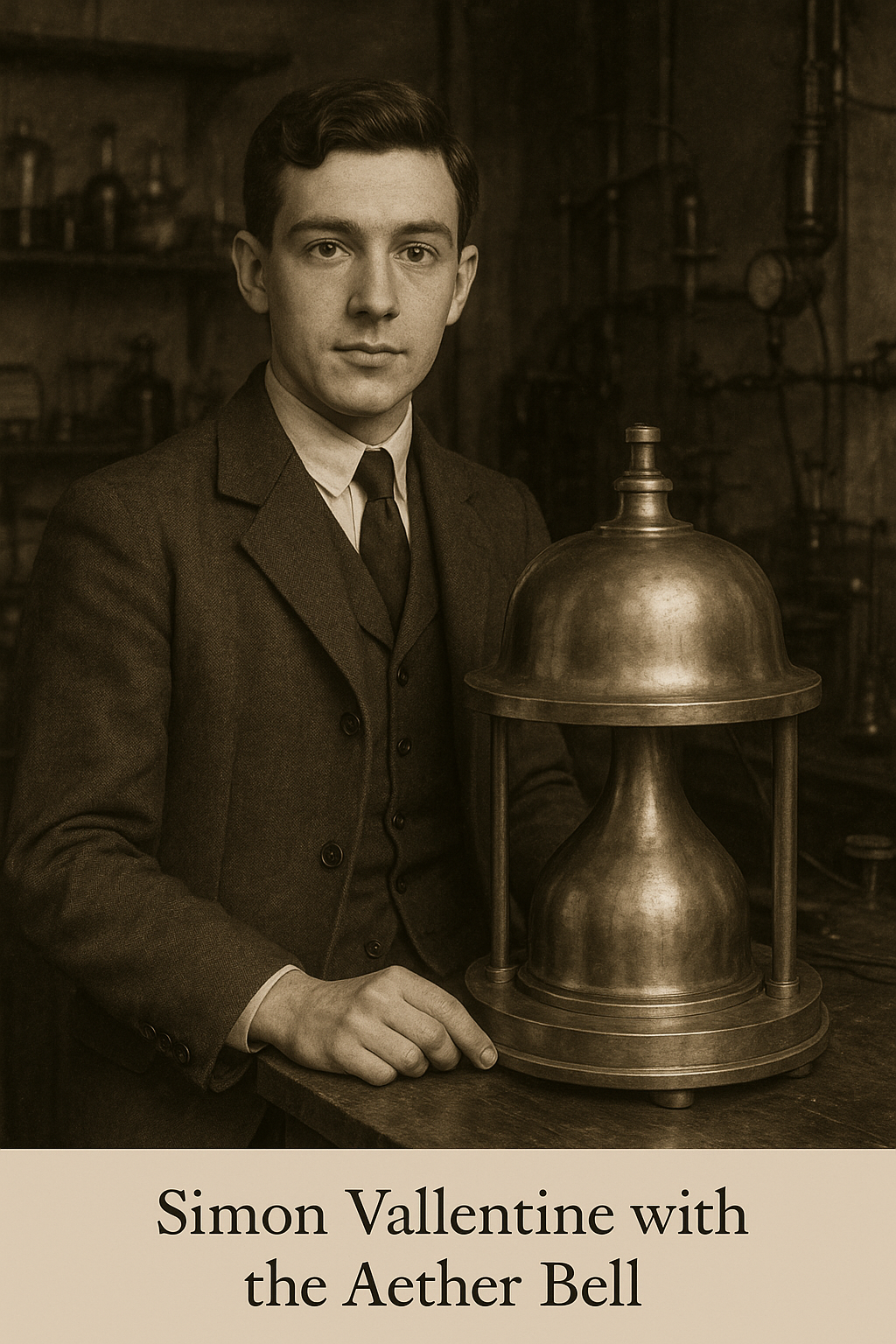
Captured in the post-war clarity of 1921, this sepia portrait shows a matured Simon Vallentine at age 29, standing beside the enigmatic Aether Bell in his private laboratory. Now a respected figure in experimental physics, Vallentine’s calm presence and precise attire reflect both his discipline and the gravity of his work. The Aether Bell, central to his controversial field resonance theories, rests solidly at his side—a silent witness to the era’s boundary-pushing scientific ambition.
Over time, prolonged exposure to the Aether Bell’s resonances appeared to have cumulative psychological effects.
In early 1922, during a standard calibration cycle, Simon reported hearing his own name called—not from among his colleagues, but “from within the frame of the Bell itself.”
-
Initially, he dismissed the voice as an auditory echo caused by harmonic interference.
-
However, the voice persisted, reportedly growing more distinct, urgent, and personal.
-
Simon steadfastly refused to acknowledge it, citing his commitment to maintaining rational detachment—a refusal that contradicted internal protocols, which demanded immediate acknowledgment and documentation of any cognitive incursions.
His official dismissal was swift.
The report cited:
“Failure to engage with emergent communicative phenomena constitutes gross dereliction of exploratory duty.”
Some believe that the act of ignoring the voice prevented a catastrophic breach. Others whisper that by refusing to answer, Simon doomed himself to perpetual resonance, his name endlessly cycling through the Bell’s hidden layers.
Notable Traits & Beliefs:
-
Skeptical Rationalist:
Unlike many StormCroft staff of his era, Simon resisted the house’s more occult explanations for resonance phenomena, insisting that all events could eventually be measured and explained through science. -
Master of Microcalibration:
His ability to sense and correct minute distortions—often smaller than a semitone’s width—made him invaluable in early Bell Room operations. -
Emotional Shielding:
Vallentine practiced what he termed “emotional bracketing,” deliberately suppressing instinctive reactions in high-risk environments to avoid resonance feedback—a technique now loosely codified in Fog Transport personnel training.
Connections:
-
Edwin Finch-Wren (Grandnephew of Octavius Wren):
Worked briefly alongside Vallentine during early experiments in portable resonance devices. Their letters reveal a mutual respect, but growing tension over the place of “intuition” in resonance management. -
Lilian Carew (Sound Archivist):
Lilian, tasked with documenting the bell’s sound emissions, recorded Vallentine’s vocal anomalies and later speculated that his refusal to respond may have “left a signature in the resonance layers themselves.”
Post-Dismissal Theories:
-
Lingering Presence:
Some Bell Room workers reported, years after Vallentine’s departure, hearing his precise voice whispering calibration figures during maintenance—even when no such figures were relevant. -
Copper Harmonics:
His dampener designs, though still used, occasionally produce sub-harmonic ringing believed to “carry remnants” of Vallentine’s experimental cycles. -
Frame Echoes:
A classified 1954 StormCroft internal memo proposed the theory that Vallentine’s aetheric pattern remains partially embedded in the Bell’s structural framework—a living imprint of a mind refusing to listen, or perhaps refusing to answer.
Legacy at StormCroft:
-
Vallentine Sleeves:
His copper sleeve dampening method remains an essential part of any protocol involving high-risk harmonic containment. -
Vallentine’s Protocol:
A now-suppressed internal directive once urged technicians to always respond if addressed by resonance entities, an implicit acknowledgment of the price Vallentine paid for his resistance. -
The Silent Name:
Technicians assigned to the Bell Room today are warned never to speak the name “Simon” within the frame of the Bell—lest they rekindle a conversation best left unfinished.
Clara Bevel
Role:
Personal Assistant to Octavius Wren
Years Active:
1869–1888
Biography
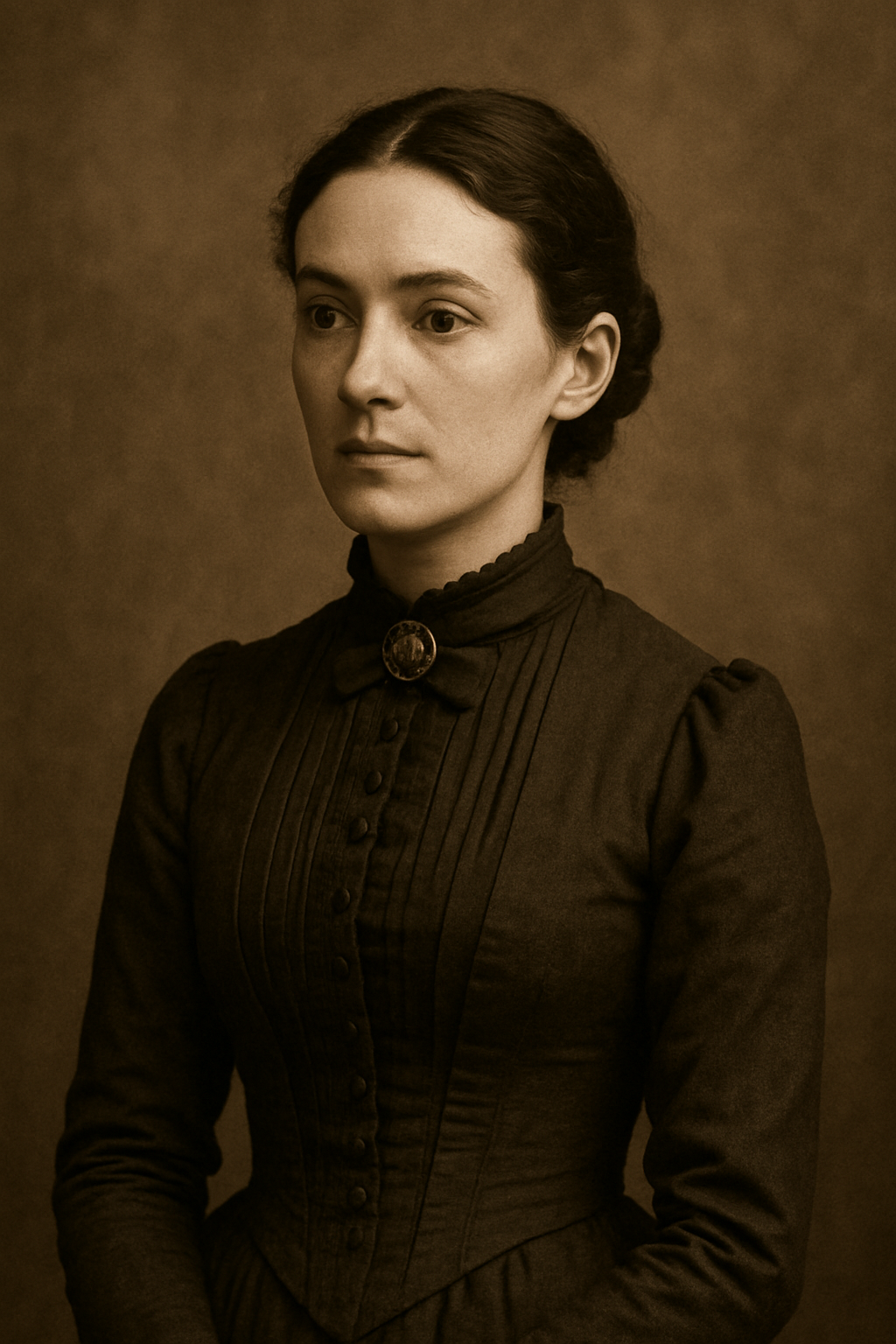
A sepia-toned studio photograph capturing Clara Bevel in her early thirties, during her tenure as Personal Assistant to Octavius Wren. Dressed in a high-collared black dress with fine pleating and a modest brooch, Clara’s composed, watchful expression reflects the quiet intelligence and unwavering discretion for which she was known. Taken just a few years before her mysterious disappearance, this rare portrait offers a glimpse into the enigmatic figure remembered by StormCroft staff as “the whisper between doors.”
Clara Bevel entered the service of Octavius Wren in 1869 at the age of twenty-two, selected for her exceptional organisational skills, calm demeanour, and what Wren referred to as “her intrinsic attunement to the quiet movements of knowledge.” She quickly became indispensable, not merely as a secretary but as a confidante and silent architect of StormCroft’s lesser-known endeavours.
Her primary duty was filing, indexing, and securing Wren’s uncirculated designs — sketches, mechanisms, and architectural concepts considered too controversial, dangerous, or unfinished to be released beyond StormCroft’s walls. These included early treatments of fog-trace resonators, energy-dampening corridors, and translocation chamber schematics.
Clara became known among the household staff as “the whisper between doors” — a testament to her nearly spectral presence within the manor. She moved quietly, often unseen, carrying sensitive documents between locked rooms and restricted zones. Her intuition for discretion was legendary; it was said that if a secret was shared with Clara Bevel, it became a “fixed star” — immovable and unreachable.
Notably, Clara described and documented non-Euclidean corridors — hallways that appeared to defy standard geometry, looping or extending in impossible ways. Her sketches and notes predate the formal scientific understanding of non-Euclidean space by several decades. Her internal reports speak cryptically of “angles that summoned memory from stone” and “staircases that climbed themselves.”
Personality and Skills
-
Intelligent, highly literate, with a background in mathematics and classical philosophy.
-
Meticulous, prone to ritualised habits (such as triple-checking locks and measurements).
-
Introverted but with a piercing perception of the motives of others.
-
Skilled in ciphers and record-keeping, often inventing her own methods of classification to obscure sensitive materials.
Wren valued her precise, almost mechanical reliability, noting privately that Clara was “the last agent I would trust to guard the mind from its own collapse.”
Departure and Disappearance (1888)
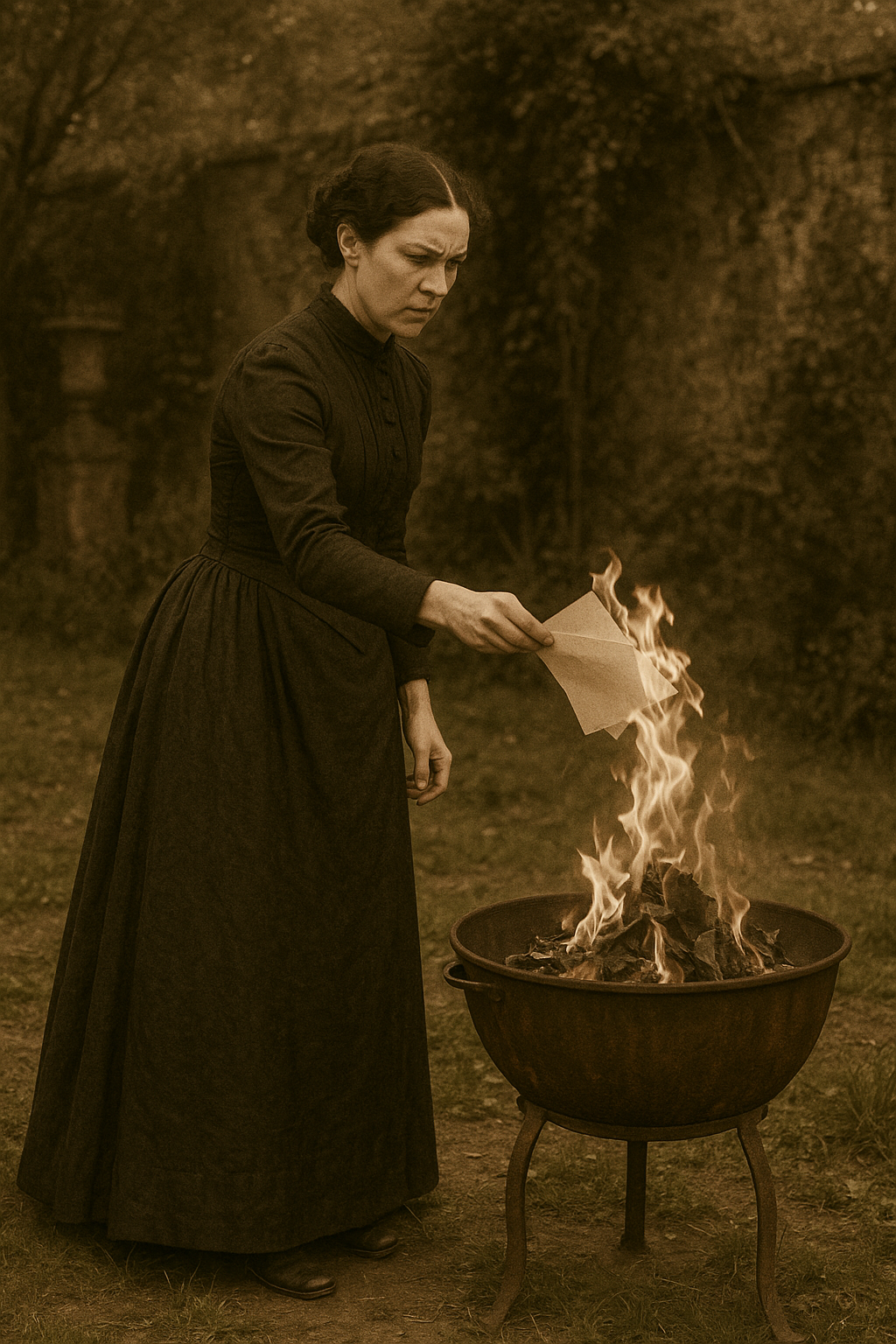
Captured in the overgrown garden of StormCroft House, this rare 1888 photograph shows Clara Bevel solemnly burning her private journals in a rusted brazier. Dressed in her customary high-collared black dress, she stands composed amid the ivy-draped ruins, her face marked by resolve. Within days of this quiet ritual, Clara vanished without explanation—leaving behind ash, silence, and a mystery that endures in StormCroft lore.
In early 1888, following a period of increasingly erratic behaviour from several StormCroft staff members (widely believed now to have been caused by experimental exposure to “fog resonance”), Clara systematically burned all of her personal journals in a controlled bonfire in the manor’s east courtyard.
Witnesses claimed she worked through the night, feeding page after page into the flames with what was described as a “quiet, deliberate sadness.”
Shortly afterward, Clara Bevel vanished without a trace. No resignation, no forwarding address, no clues. Her locked filing cabinets were found emptied save for a single slip of paper bearing the phrase:
“Where corridors end, I will begin.”
Despite exhaustive searches by Wren and later archivists, no verified sighting of Clara Bevel has ever been recorded after 1888.
Legacy
-
Many of Wren’s “lost designs” are thought to have been spirited away or destroyed by Clara.
-
Later StormCroft engineers referenced her filing system, which they dubbed “the Bevel Method,” for its labyrinthine yet foolproof security layers.
-
Legends persist that some of her non-Euclidean sketches survived, hidden in locked rooms deep within StormCroft House, awaiting rediscovery.
Symbolically, Clara Bevel has become an emblem within StormCroft’s private lore — the archetype of the “silent guardian” whose loyalty to knowledge superseded loyalty to any living master.
Arnold Hatch
Role: Gate Guard and Timekeeper
Years Active: 1905–1915
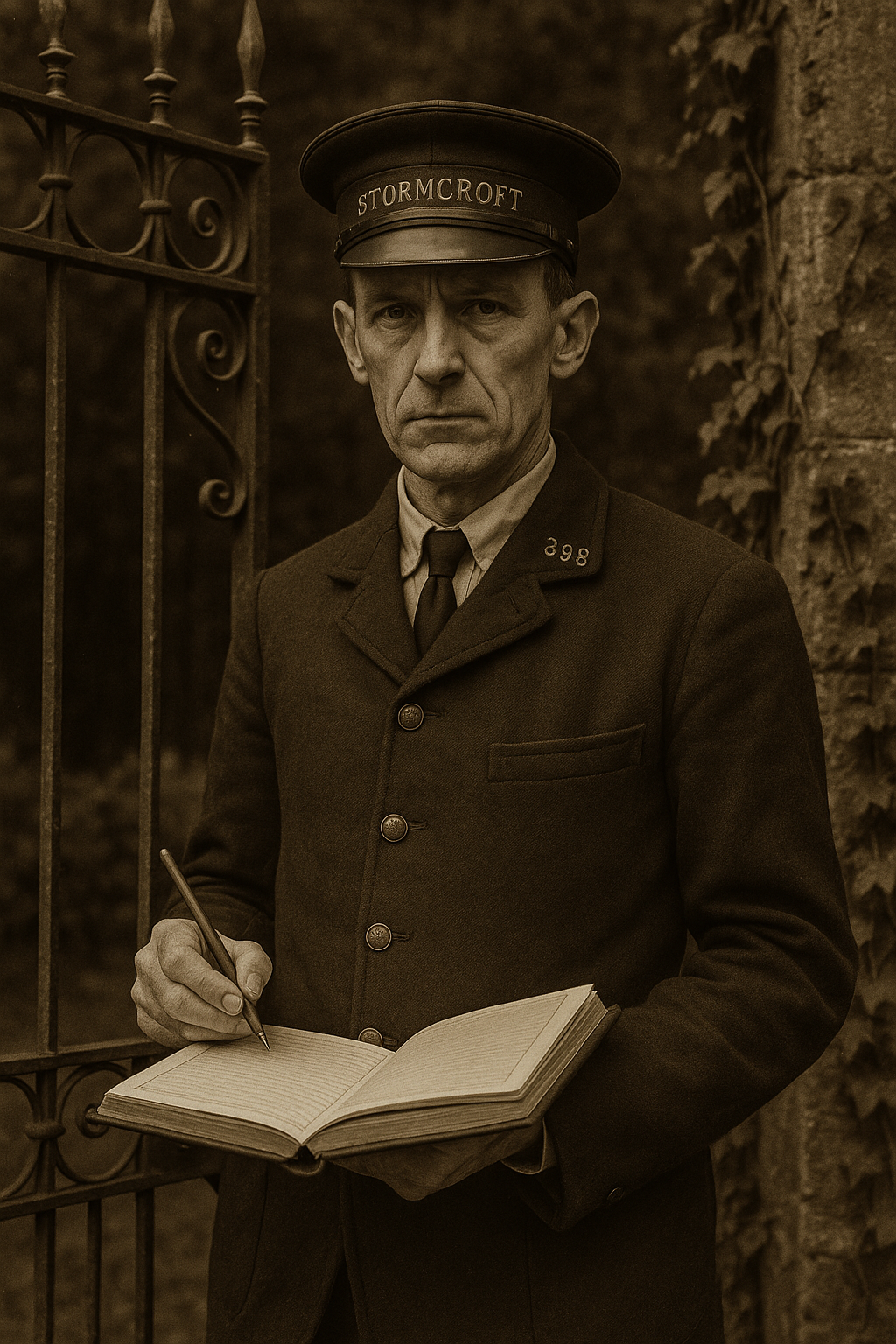
This sepia-toned photograph captures Arnold Hatch, StormCroft’s Gate Guard and Timekeeper, standing vigil at the wrought-iron South Gate with logbook in hand. His stern expression and regimented uniform reflect the seriousness of his role—recording all entries and exits from the estate with unerring precision. Taken months before the mysterious stoppage of his clocks in 1915, this rare image embodies the watchful stillness that defined Hatch’s final year at StormCroft.
Biography: Kept written log of all who entered and left the estate — including six names no one else recalled. His clocks all stopped in June 1915. He insisted that no one had entered since the previous August.
Here is a narrative focused on Arnold Hatch, the gatekeeper whose timekeeping records fractured the perceived truth of StormCroft’s operations between 1914 and 1915. This piece introduces the six names no one else remembered, and explores the eerie disconnection between observed time and official record.
The Forgotten Six: The Hatch Ledger Anomaly (1915)
“He did not miss time. Time missed him.”
— Note in the 1983 Loop Room audit margin, regarding Arnold Hatch
Overview
Arnold Hatch, a quiet but punctual former railway clerk, served as StormCroft’s gatekeeper and timekeeper from 1905 until his departure in 1915. Stationed in the East Gate Lodge, Hatch was responsible for logging every individual who passed through the perimeter — arrivals, departures, repeat entries. His logbooks were famously detailed and neat, down to the second.
Until, abruptly, they weren’t.
In June 1915, all of Hatch’s clocks stopped. Not one, not two — all seven independent timepieces in his quarters froze at 3:01 a.m., without power failure or mechanical defect. When questioned, Hatch said only:
“There has been no arrival since last August. No departure either. Only watching.”
But his logs tell another story. Between August 18th and November 4th, 1914, Hatch records six arrivals. Each with names no one else remembered. Each bearing peculiar characteristics. None appearing in housing records, servant rosters, or meal logs. None seen by other staff.
StormCroft would later classify this as the Hatch Ledger Anomaly.
The Forgotten Six (Names from Hatch’s Ledger, Logbook IV)
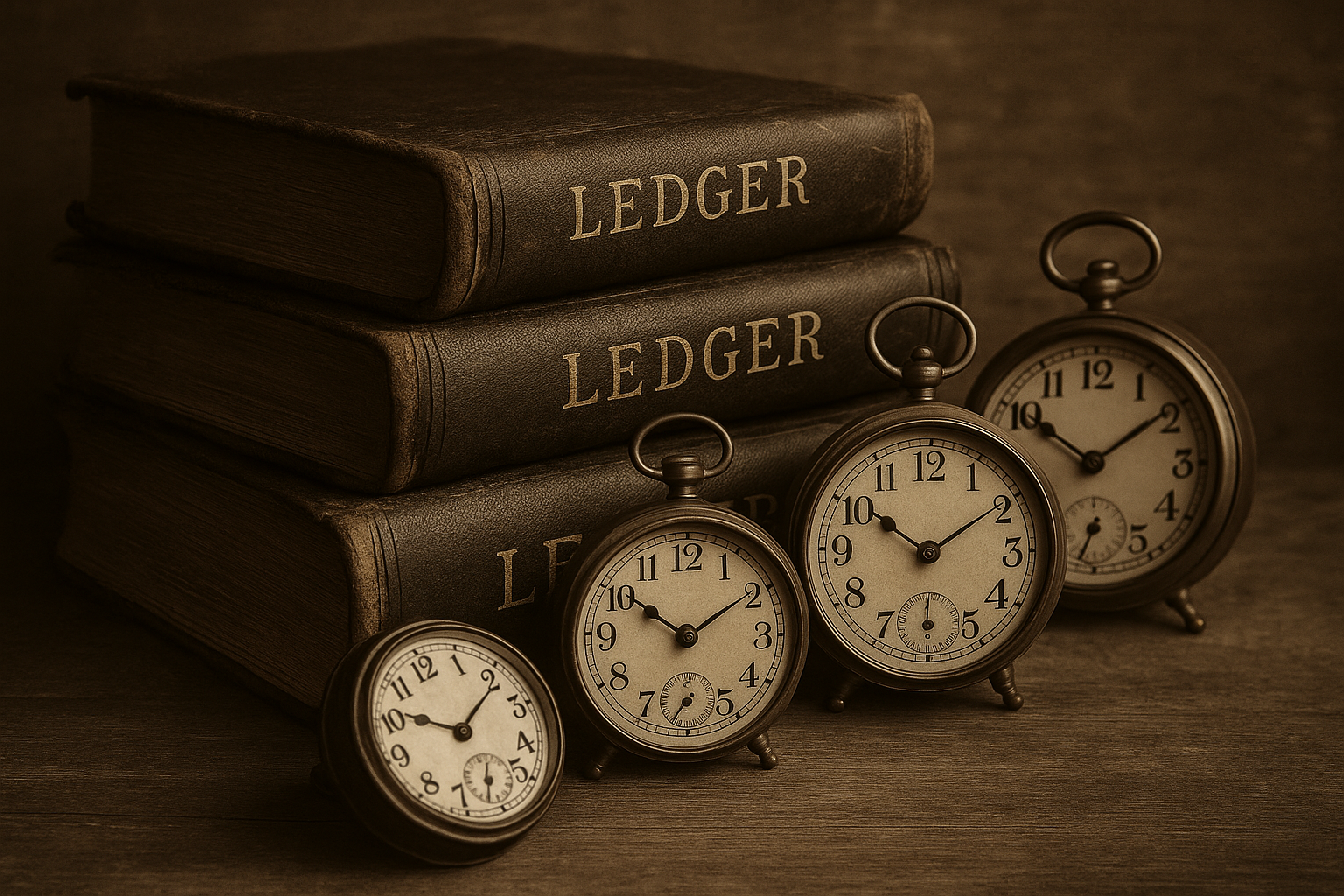
This evocative 1916 sepia photograph captures the aftermath of Arnold Hatch’s vanished presence: three heavy leather-bound ledgers stacked in precise order, and four brass timepieces—one tipped onto its side, as if discarded or disturbed. The clocks remain frozen, each marking a different hour, their silence echoing the unexplained cessation of time that struck StormCroft the year prior. An image both archival and unsettling, it speaks to the fracture between recorded order and unseen chaos.
1. Elias Greystone
Date of Entry: August 18, 1914
Notes: Tall, narrow-shouldered man in mourning attire. Claimed to be “returning from dormancy.” Hatch wrote: “Smelled of metal. Handshake was too slow.” Never seen again.
Possible link: Name matches an architect from 1826 who disappeared designing a spiral asylum wing.
2. Mrs. DeClarke (No Initial)
Date of Entry: August 31, 1914
Notes: Elderly woman with a box containing “her own key.” She insisted on walking backward from the gate to the west wing. Hatch noted: “She thanked me for a cup I hadn’t offered yet.”
Aftermath: The west wing developed condensation that week, despite a dry forecast.
3. “Roland” (No surname given)
Date of Entry: September 9, 1914
Notes: Boy, approximately 11 years old. Entered alone, no luggage. Wore a tag around his neck reading “SECOND CALL.” Hatch wrote: “Eyes didn’t blink the same way. He waved goodbye to the house before stepping inside.”
Strange echo: The Quiet Loop recorded a child’s voice whispering “thank you” on the same day.
4. Dr. Ives Malkin
Date of Entry: September 21, 1914
Notes: Arrived by bicycle. Introduced himself as a “temporal hygiene inspector.” Left behind a small copper disk, later discovered under Hatch’s cot. Hatch wrote: “He kept checking the sun without looking at it.”
Unlisted: No employment records exist under this name.
5. Unnamed Woman (“The Signalwife”)
Date of Entry: October 7, 1914
Notes: Entered without speaking. Placed her hand on the east pillar and stood still for thirteen minutes. Hatch describes her as “Wearing too much black. Too still. When she blinked, her neck creaked.”
Residual: That pillar cracked vertically three days later.
6. The Other Hatch
Date of Entry: November 4, 1914
Notes: This entry only reads: “He looked like me. But I had the logbook.” No signature.
Implication: An impossible double? This was the final name before all clocks froze.
Investigation and Aftermath
After the final recorded arrival, Hatch was found standing outside the gate on the morning of June 14, 1915, holding his ink pen like a compass needle. His uniform was scorched on one side, as though burned in a perfect vertical line. He refused to re-enter the lodge and claimed:
“They haven’t left yet. Because they were never let in. But I watched them go.”
He retired one week later. The lodge was sealed. In 1940, during renovations, the copper disk left by Malkin was recovered and placed near an inactive CroftNet node. It pulsed three times before crumbling into ash.
Possible Interpretations
-
Temporal Interference: All six arrivals may have occurred outside of the accepted timeline. Hatch may have been exposed to Layer Drift, a known phenomenon described in Finch’s notes.
-
Non-physical Manifestations: Several staff at the time suggested these individuals were “resonant projections” tied to the Bell Room during its first reactivation cycle.
-
Containment Breach Echoes: It’s possible that Hatch witnessed the memory of future arrivals, projected backward via Loop pressure — a theory never proven, but often whispered.
Legacy
In 1983, while digitising old materials, archivist Leo Fenner isolated a degraded audio fragment from a Loop Room tape. In it, a low voice — faint and rhythmic — is heard repeating:
“Six passed. One stayed. None belonged.”
It is believed to be Hatch.
Delia Marsh
Role: Dream Cycle Recorder
Years Active: 1920–1927
Overview

This rare sepia photograph captures Delia Marsh in her final year at StormCroft, seated at her recording desk in the dim confines of Room 9-B. Surrounded by dream transcripts, wax cylinders, and the soft glow of an oil lamp, Marsh transcribes the spoken remnants of another’s sleep. Her gaze, distant yet focused, hints at the burden of documenting what she could no longer experience herself. The photograph is believed to have been taken weeks before the event known as The Concordance.
Delia Marsh was employed by StormCroft House during one of its most opaque and ethically questionable initiatives — the Loop Subject Programme, which began in late 1919 and formally expanded in 1920 under the directorship of Dr. Almeric Vale. Marsh’s official title was Dream Cycle Recorder, but among staff she was known more cryptically as “The Waking Ear.”
Her job was to document the dreams of looped test subjects — individuals placed under experimental “cycle compression” meant to simulate extended periods of subconscious time. Most were low-ranking staff, volunteers, or orphans pulled from nearby facilities. Marsh’s recordings, done via wax cylinder and shorthand, would later be transcribed into what became the Marsh Dream Index, a volume of troubling consistency and symbolism.
The Work
Delia operated from a small, sound-dampened room off the east wing, fitted with a copper venting horn and lined with strips of wool. She slept irregular hours and worked with a lamp that never fully dimmed. Her process was simple but unnerving: each Loop Subject, immediately after exiting the experiment, was brought to her while still disoriented. They would recount their dreams aloud, sometimes speaking in unknown languages, sobbing, or repeating fragments.
Marsh would sit, hands folded in her lap, and repeat the dreams softly under her breath as she transcribed them. Her eyes remained open. A mirror was kept near her desk, though its purpose was never recorded.
She was particularly skilled in identifying “persistent symbols” — dream motifs that recurred across unrelated subjects. Some examples from her 1922 log include:
-
“a staircase melting into paper”
-
“the red door that breathes”
-
“the man with no eyes, only listening”
-
“the bell in the sea”
These symbols were later correlated with StormCroft spatial anomalies, though Delia herself made no interpretations. Her motto, found pencilled in the back of her transcript book, read:
“I write, I do not conclude.”
Sleep Loss and the Unspoken Dream
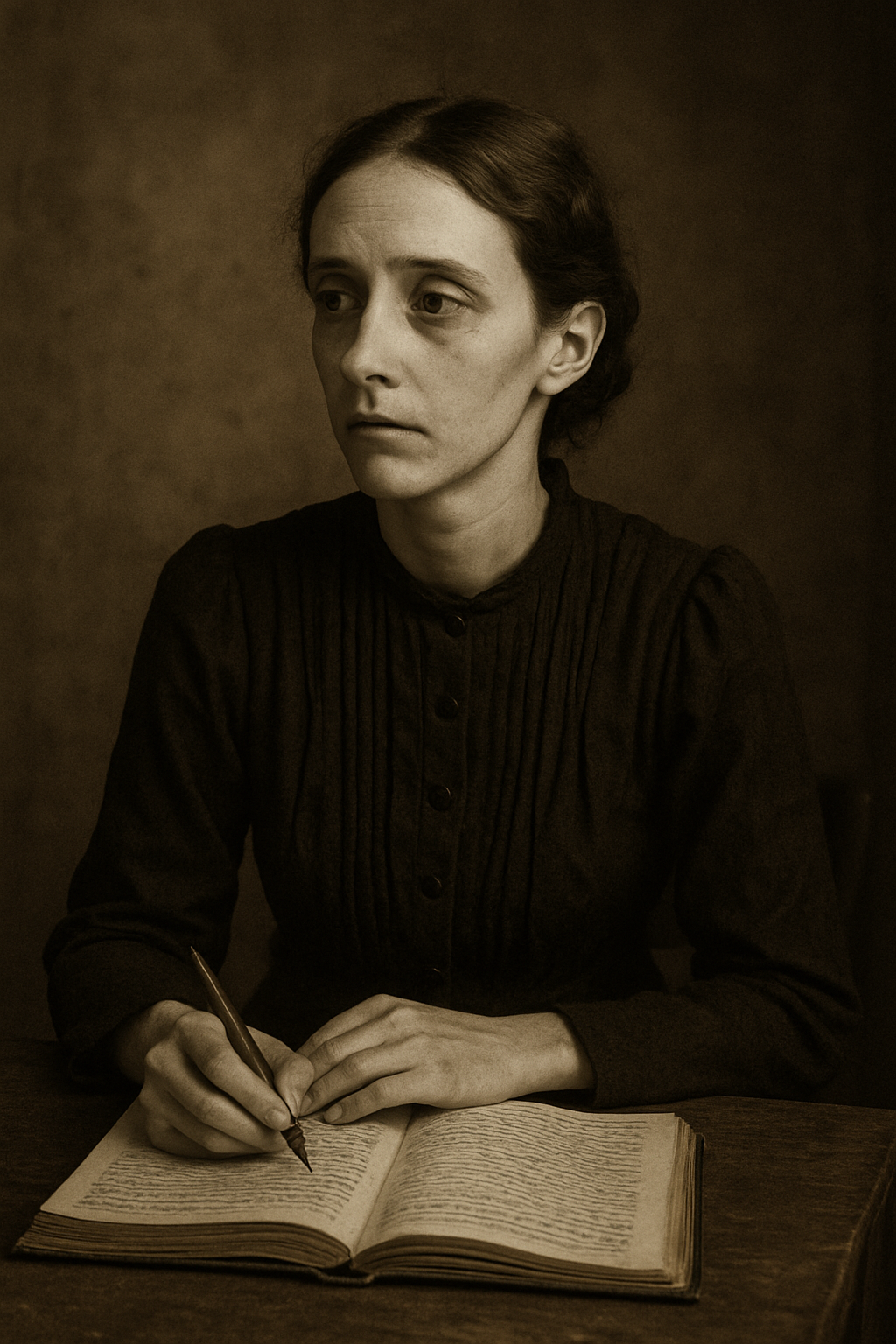
In this haunting 1926 photograph, Delia Marsh sits at her desk, her hand resting on a half-written dream transcript, eyes distant with the weight of sleeplessness. Taken during the period when she claimed to have lost the ability to sleep, her faded complexion and stillness convey the surreal state she described as “waiting in a space where sleep used to be.” This image marks the beginning of her final descent—when she believed she was no longer dreaming, but holding the dreams of others.
In March 1926, Delia Marsh reportedly began losing the ability to sleep. She described the sensation not as insomnia, but as “waiting in a space where sleep used to be.” Her complexion faded, her writing slowed, but she refused reassignment. She claimed her mind was “holding dreams for others now.”
On 17 October 1926, she transcribed a dream from memory, claiming she had never heard it spoken aloud, but felt compelled to write it “as if dictated from the wall behind [her] head.” The dream was vivid, involving:
-
A group of children running into a collapsing chapel
-
The discovery of a sealed door behind a curtain
-
The phrase: “You mustn’t wake up where you did not sleep”
Six weeks later, a young Loop Subject named Elias Wren (no known relation to Octavius) described the exact dream, word for word — including tone, cadence, and breaths — despite never having seen Delia’s notes.
This incident, known within the archives as The Concordance, was redacted in subsequent records.
Disappearance and Legacy
Delia Marsh vanished in early 1927. Her final known location was Room 9-B, where she had reportedly locked herself in “to listen for the dream.” When staff forced the door, the room was empty. Her desk was cleared save for a blank wax cylinder and the words etched into the wooden wall:
“I have gone ahead to take dictation.”
Legacy
-
The Marsh Dream Index (Vol. I–V) is stored in Vault D-4, sealed for psychological risk.
-
The Unspoken Dream Transcript remains classified under “recursive phenomena.”
-
A drawing from a later subject includes a perfect likeness of Marsh, years after her disappearance, seated at a desk “with no mouth, only a listening ear.”
Delia Marsh is remembered within StormCroft as a figure of fragile brilliance, one who recorded the dreams of others until the act of transcription consumed her own sleep and, perhaps, her selfhood.
Marcus Pelham
Role: Subterranean Cartographer
Years Active: 1931–1940
Overview
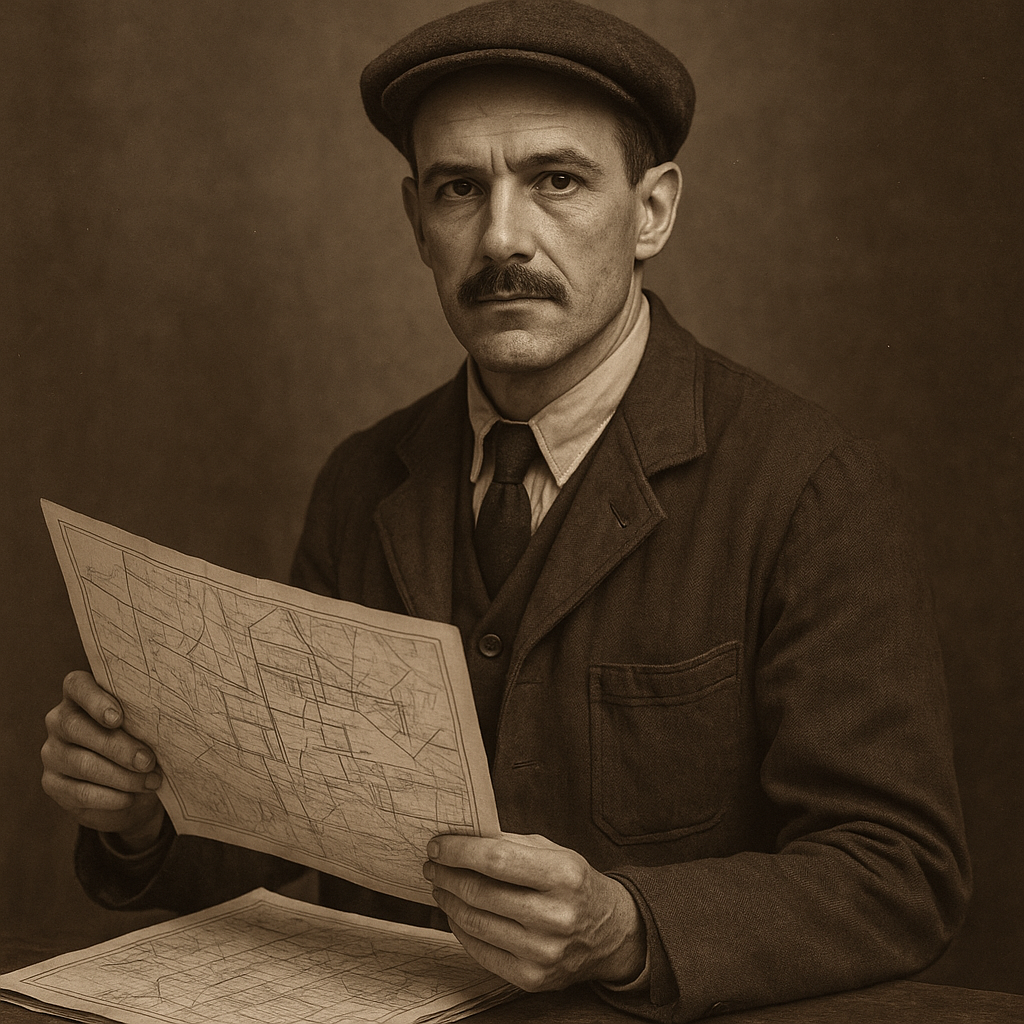
This rare sepia portrait captures Marcus Pelham mid-task, holding one of his incomplete subterranean maps of StormCroft’s anomalous Zone 4B. Dressed in workman’s wool with a flat cap and focused expression, Pelham appears both alert and weary—an embodiment of the precision and psychological toll required to chart corridors that refused to remain still. The sharp folds of the vellum in his hands contrast with the recursive geometry sketched upon it—symbols of a logic that only he dared follow underground.
Marcus Pelham served as StormCroft House’s Subterranean Cartographer during a crucial phase of the estate’s deep structural survey and expansion. Hired in 1931 following the partial collapse of Vault Sector E-Delta, Pelham was tasked with charting disused, undocumented, and anomalous lower levels, many of which had not been entered for decades—or perhaps, as some believed, not in any linear sense of time at all.
With a background in mine plotting and deep-shaft reconnaissance, Pelham brought a mix of technical rigour and intuitive navigation. He became the first and only cartographer assigned to Zone 4B — a restricted sector beneath the east archive vaults, noted for recurring distortions in distance, orientation, and cognition.
Work and Methods
Pelham’s tools were traditional: grease pencil, vellum sheets, and a customised multi-compass plate that included magnetic, solar, gravitational, and “gut-based” bearings (a term he coined to describe an inexplicable internal pull he sometimes followed instead of instruments).
He travelled with a fixed kit:
-
Two oil lanterns (one shaded blue, one open flame)
-
A mechanical odometer cart modified to “click in reverse”
-
A copy of the 1889 Wren Foundation Plans, annotated in red
-
Chalk line, black thread, and a brass clicker for echo measurement
Pelham’s early sketches of the lower blind shafts, vault halls, and “sealed driftways” were deemed reliable until he began working in Zone 4B, where his notations grew increasingly erratic and metaphysical.
Zone 4B: Directional Reversal and Cognitive Dissonance
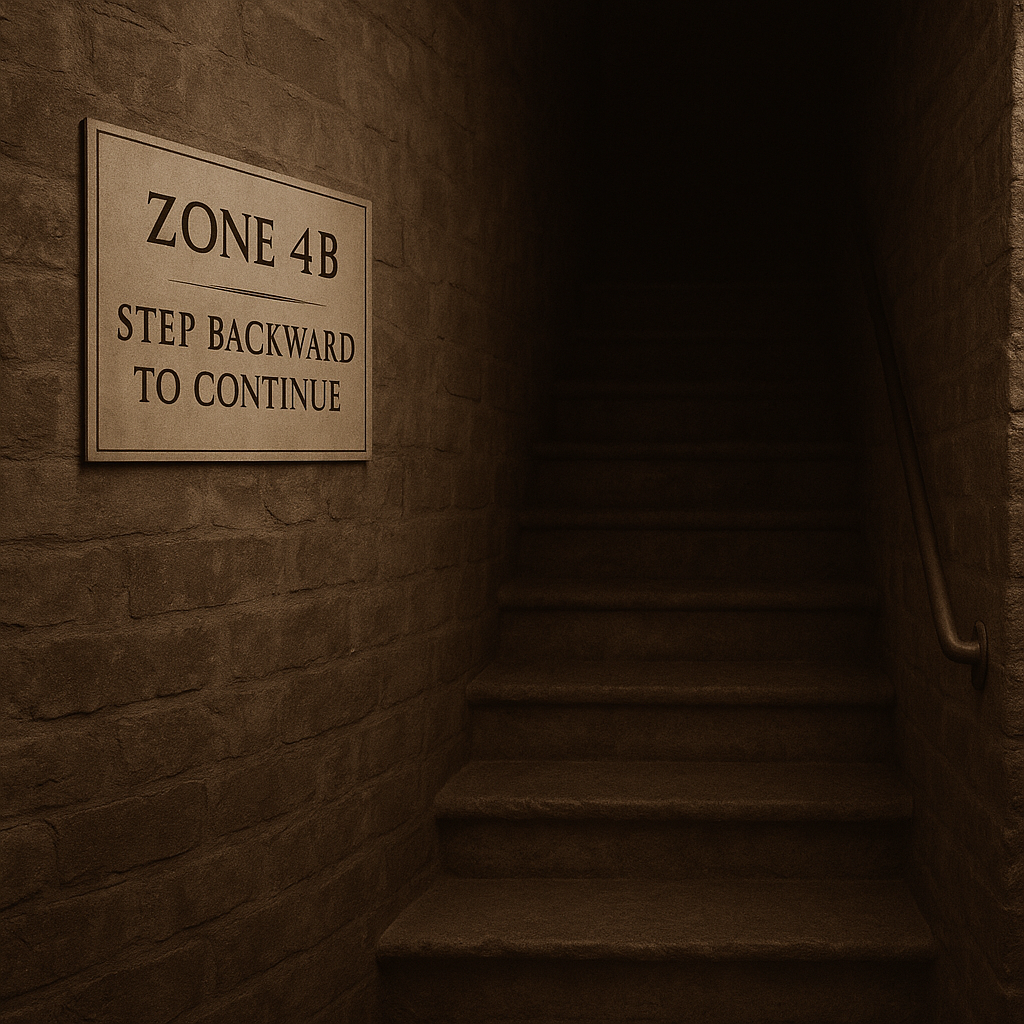
This 1930s-era photograph captures the entrance to StormCroft’s infamous Zone 4B — a narrow, descending stairwell lined with worn stone and heavy shadow. Affixed to the left wall, a metal plaque reads: “ZONE 4B – STEP BACKWARD TO CONTINUE”—a warning and instruction simultaneously. The sign, though weathered, remains clear, a relic of Marcus Pelham’s traversal through the zone where spatial logic inverts and thought precedes movement. Few returned beyond this point with the same sense of orientation—or self.
First entered on 12 February 1934, Zone 4B was described in Pelham’s logs as “a spatial quadrant wherein movement defies witness and direction undoes itself upon record.”
He noted:
“To reach the lower level, I must step backward in thought — reciting equations or old injuries — while my feet descend. If I think forward, I ascend, regardless of motion.”
Zone 4B was the site of his most cryptic mapping — tunnels that loop but terminate, stairwells that change material halfway through, and chambers that unrecord themselves after departure. His final working sketch of the area was labelled “incomplete by necessity.”
Among Pelham’s marginalia:
-
“Up leads down. East smells wrong.”
-
“The echo follows now, not precedes.”
-
“What I mapped yesterday has moved.”
-
“There are doors that open without sound, and one that opens in sleep.”
Incident and Departure
On 3 June 1940, during an unauthorised solo return to 4B, Pelham failed to report back. He was found two days later, asleep in a standing position at the threshold of a dead-end corridor, his lantern burned out and his map reversed.
He was coherent but changed. Pelham claimed he had not slept, but rather had “waited in the room while [his] body searched.” He was reassigned to surface duties for the remainder of the year and retired in December 1940, refusing all interviews.
His final note, written in pencil across his reversed Zone 4B map, read:
“There is no true map of the place. You draw it by surviving.”
Legacy
-
Pelham’s maps are held in the Lower East Archive, stored in a lead-lined drawer due to unexplained static emissions from the vellum.
-
A stairwell in Zone 4B bears a plaque: “Step backward to continue.”
-
His clicker odometer is preserved in the StormCroft Tool Repository, labelled “Recovered. No longer ticks.”
-
The Marcus Pelham Mapping Method (MPMM) is still cited in modern irregular spatial studies, especially his formula for “recursive void avoidance.”
Pelham is remembered not only as a cartographer of unwalkable paths, but as one of the few to return from Zone 4B — albeit not entirely as he left.
Beatrice Linney
Role: Communications Monitor
Years Active: 1952–1961
Overview
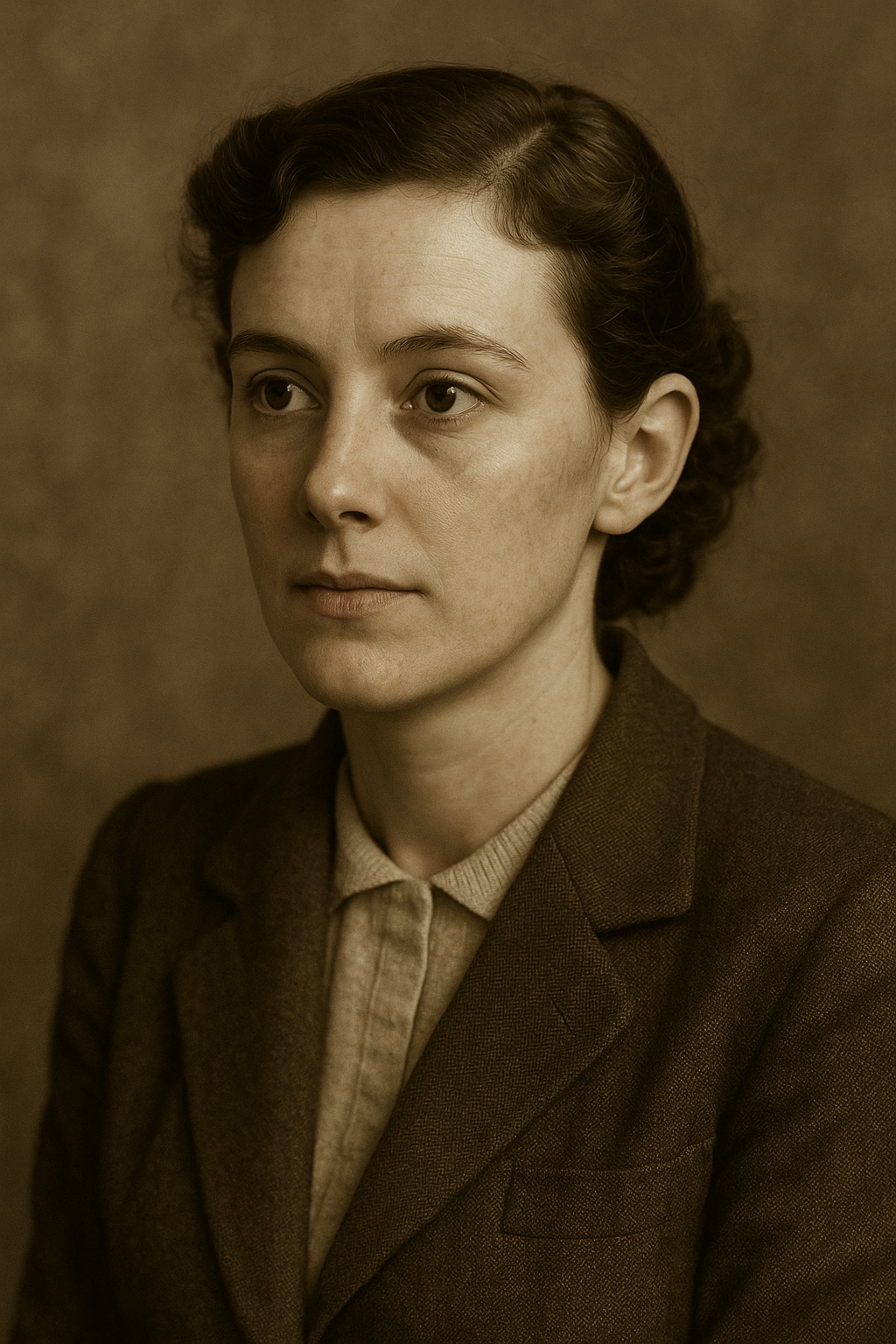
This formal 1954 sepia portrait captures Beatrice Linney during her early tenure as Communications Monitor at StormCroft. Poised and focused, she wears a textured wool blazer and collared blouse — the standard uniform of Relay Post G-3 personnel. Her expression is composed yet distant, reflecting the solemn discipline required of one tasked with listening to the innermost signals of CroftNet. This image was taken eight years before she would intercept a transmission that arrived too early — and walk away forever.
Beatrice Linney joined the StormCroft Communications Annex in 1952, part of a post-war initiative to restore and expand the internal signal infrastructure known as CroftNet — a closed-loop, encrypted audio-frequency system that operated across the estate’s subterranean levels, aboveground towers, and remote testing sites. Linney’s role was to monitor and transcribe all inbound signal bursts, maintain frequency hygiene, and ensure no anomalies bled into the outside grid.
She was a former Royal Signals interpreter, known for her extraordinary mnemonic retention and methodical temperament. Her posting to StormCroft followed the unexplained failure of the “Echo Loom” relay tower in 1951 — a position many suspected involved more than routine technical listening.
Work and Function
Linney’s daily work was solitary. She operated from Relay Post G-3, an acoustically shielded room lined with copper sheeting and fitted with vintage Bakelite headsets, reel-to-reel magnetic recorders, and a live-translation ticker (an experimental phonetic-to-type interface developed on-site). She monitored CroftNet for tone disturbances, unscheduled pulses, and encoded transmissions, most of which were chalked up to line degradation or ghost echoes.
Her logs were precise, written on carbon triplicates filed in tripartite drawers: Routine, Unverified, and Unrepeatable.
The Transmission: 11 March 1961
At 02:14 a.m. on the morning of 11 March 1961, Linney intercepted an unexpected burst across Channel F-19, a dormant frequency last activated during a 1956 weather resonance trial. The transmission was short — six seconds in length, marked by a high-frequency carrier tone followed by a structured pulse pattern. The message was initially incomprehensible.
After transcription and repeated analysis, the signal, when translated using a phonetic-substitution cipher Linney claimed “came to her in a chill,” revealed the following instruction:
“DO NOT COMPLETE THE CIRCUIT.”
The message was time-stamped and filed as Unrepeatable. It bore no known origin, routing, or echo. What stunned Linney and later archivists was not the cryptic content, but its prescience — the warning predated the conception of the very circuit it referenced.
Fourteen years later, in 1975, Project Circulus — a sealed energy loop designed to self-sustain spatial resonance — was formally outlined by StormCroft engineers. The message Linney transcribed had arrived before the design had ever been theorised.
Immediate Aftermath
Beatrice Linney retired the day after the incident. She offered no resignation letter, explanation, or farewell.
Her final logbook entry — neatly written, undated, and placed alone in the “Unrepeatable” drawer — read:
“If it is already sent, then someone has already tried.”
(initialled: B.L.)
She was never seen at StormCroft again.
Legacy
-
The Linney Transmission remains one of the earliest known examples of non-sequential communications phenomena within the CroftNet system. Its classification is Tier Black, and playback is restricted to Auditory Division Delta personnel.
-
Her carbon record of the event, headset, and translation strip are housed in Archive Vault 7-K, under a containment order for “resonance latency.”
-
The Beatrice Protocol — a system of multi-temporal validation checks — was introduced in 1962 to prevent forward-echo anomalies and recursive data corruption.
-
The phrase “DO NOT COMPLETE THE CIRCUIT” is etched above the Project Circulus containment gate — both a warning and a riddle still debated in StormCroft’s inner circles.
Beatrice Linney is remembered not for what she decoded, but for what she heard before it was possible to hear — and for stepping away once she had.
Gilbert Stowe
Role: Signal Tone Analyst
Years Active: 1955–1965
Overview
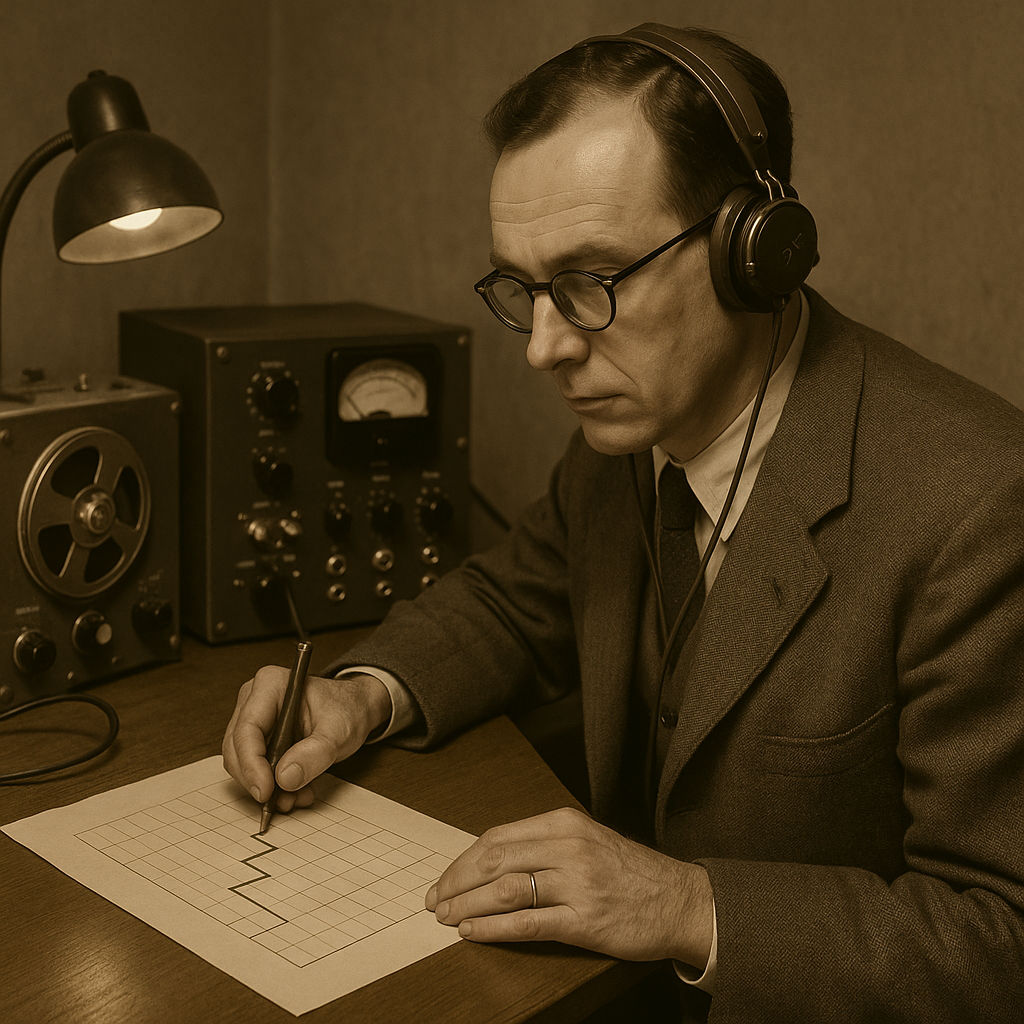
In this rare 1964 photograph, Signal Tone Analyst Gilbert Stowe sits deep in concentration at his console in the South Auditory Annex. Wearing headphones and framed by analog audio instruments and a reel-to-reel recorder, Stowe traces a jagged progression across a gridded chart—his early rendering of the now-notorious Tone Staircase. Surrounded by oscillators and low-light acoustics, this moment captures the calm before his final experiment—one that would yield a sound never meant for the born.
Gilbert Stowe was one of StormCroft’s most precise and enigmatic minds—an auditory physicist and pattern mechanic whose work in sonic architecture laid the foundation for later decoding methods used in Loop Subject trials and resonance studies.
He joined the CroftNet Acoustic Analysis Division in 1955, at the height of the post-war data recovery surge. Stowe quickly distinguished himself not through volume of output, but through his uncanny ability to identify structuring principles within raw tone series, even when they appeared to lack rhythm, modulation, or harmonic reference.
His name became synonymous with the “Tone Staircase” calibration model, a decoding method that relied on pitch inflection across non-linear harmonic intervals — allowing StormCroft technicians to isolate embedded messages in distorted or recursive Loop feedback.
The Tone Staircase
The Tone Staircase was not a device, but a concept: a layered approach to tone progression in which each “step” altered its relationship to both previous and following tones based on perceived listener resonance. The model required:
-
Subjective listener calibration (sensitive analysts, trained not to hear what should be there)
-
Pressure-adjusted auditory chambers
-
And the use of infrasonic and ultrahigh-range pitch registers, which bypassed standard human tonal frameworks
Stowe’s development of this method stemmed from his belief that “not all patterns are constructed for the hearing mind, but for the listening body.”
He once wrote in a margin:
“Pattern is not repetition. Pattern is gravity within sound.”
The Final Experiment: 1965
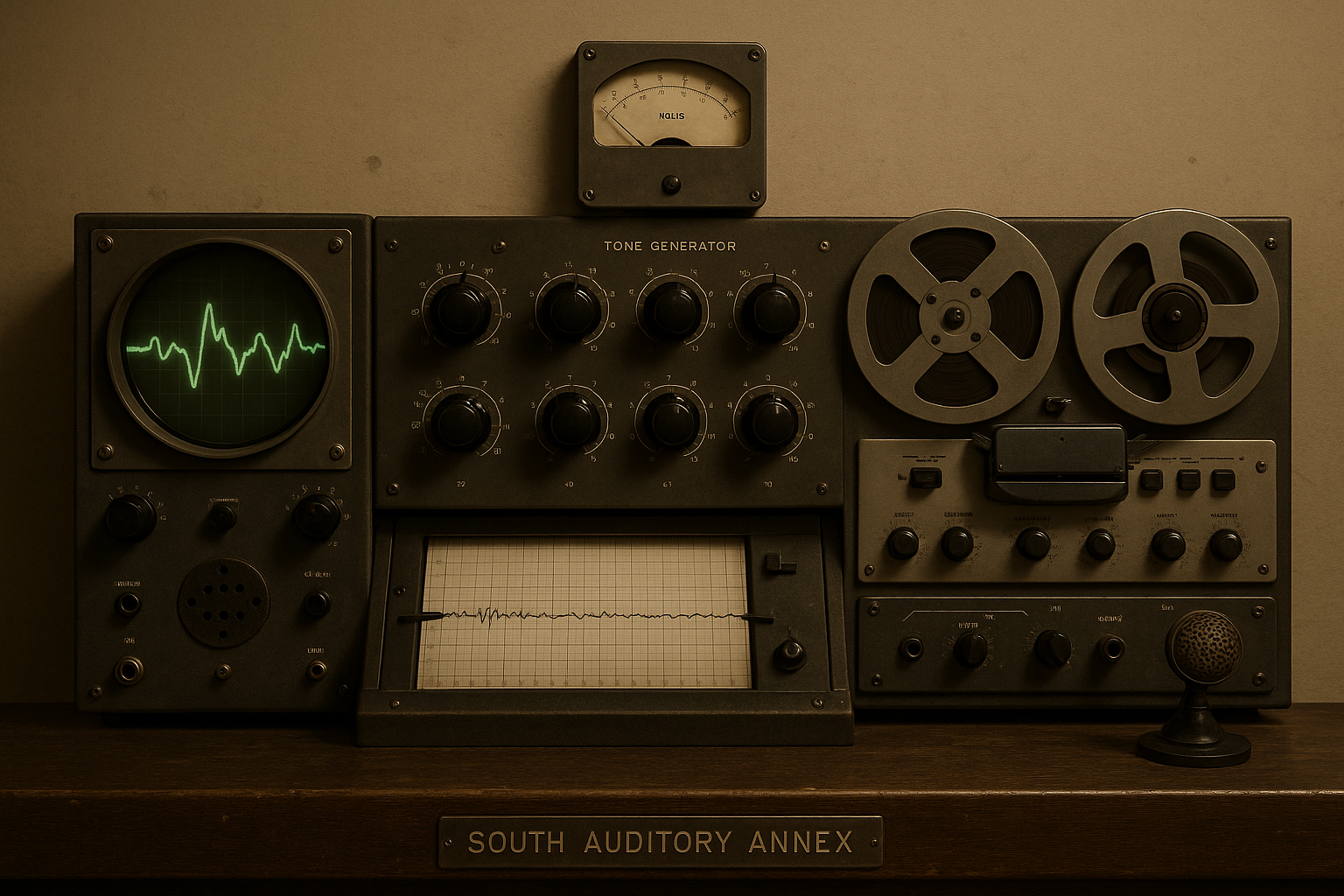
This rare archival photograph captures the full Tone Analysis Console used by Gilbert Stowe in the final phase of his work at StormCroft. Featuring a calibrated tone generator, reel-to-reel recorder, oscillograph, and a signal trace monitor, the apparatus is seen here mid-operation, with waveforms active across the displays. The label beneath the console reads South Auditory Annex, marking the chamber where Stowe decoded the tone known only as “for unborn things.” The equipment remains sealed to this day, untouched since the final playback.
On 2 November 1965, Stowe initiated a closed-circuit playback test of a previously untranslatable Loop Segment—one that had defied all prior attempts at transcription. The tone file had been recovered from a corrupted CroftNet intercept and was believed to be residue from an experimental sleep-loop exposure in 1958.
Using a customised iteration of his Tone Staircase filters, Stowe attempted to normalize the tone into recognisable harmonic layers. The result was a sustained audio construct, just over sixteen seconds long, rendered in low-murmur pulse and upper harmonic filament.
He described the playback, moments before initiating it, as:
“Familiar. But in the way a child might remember a house they were never born in.”
Observers described the playback tone as:
-
“Too still”
-
“Like breath behind glass”
-
“Something you feel just before the knock”
An assistant technician reported nausea and disorientation during the playback. Stowe stood motionless, eyes open, lips parted. After the tape clicked off, he removed his headset, calmly walked out of the chamber, and never returned.
He left no resignation, no farewell. His house in Exeter was emptied within a week. Attempts to contact him were met with silence. A single file remained in his drawer, labelled “for unborn things” — it contained a spectrogram with no notes, and a hand-drawn spiral that faded into itself.
Legacy
-
The recording played on 2 November 1965 is referred to as The Stowe Tone and is under permanent blackout, classified at Clearance 8 or above.
-
Stowe’s spiral diagram is held in Vault 9-M, known to cause disorientation if viewed for longer than thirty seconds.
-
His Tone Staircase model remains foundational in decoding post-CroftNet data anomalies, though few attempt full calibration today.
-
A metal plaque in the South Auditory Annex reads:
“He mapped tone as others map air. Then he heard forward.”
Gilbert Stowe is remembered as the analyst who heard something before it needed a listener — and chose silence over continuation.
Emily Croxley
Role: Sanitisation Officer
Years Active: 1970–1975
Overview
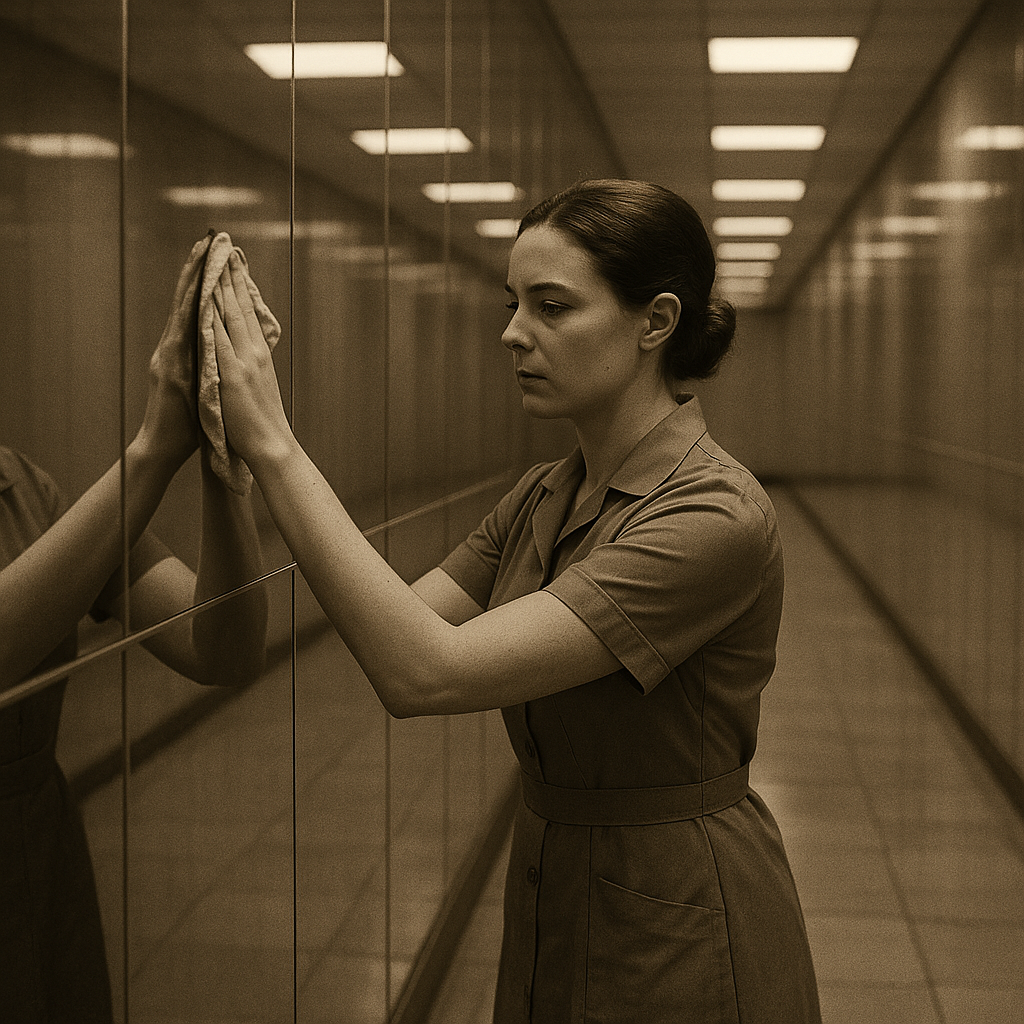
This rare photograph from 1973 captures Sanitisation Officer Emily Croxley mid-task, polishing one of the mirrored panels in Corridor E5 of the East Laboratory Wing. Her bare hands press the cloth with quiet precision, reflecting her deep commitment to manual clarity. The corridor’s endless reflections stretch behind her—clean, quiet, and uncannily symmetrical. Croxley would later report seeing “the others” only while wiping these surfaces, claiming they vanished when stillness returned. This image remains one of the last taken before the corridor was sealed.
Emily Croxley joined StormCroft House in February 1970, assigned as a Sanitisation Officer within the East Laboratory Corridor Systems, a region notorious for its humidity fluctuations, mirrored surfaces, and proximity to sealed testing rooms. Though the role was considered mundane and rarely documented, Croxley’s tenure became a matter of intense internal review due to her unusual behavioural reports, visual claims, and an incident in 1975 that resulted in her permanent reassignment.
Croxley was initially described by her supervisors as “exceptionally thorough”, often exceeding protocol standards and refusing mechanical polishers in favour of “manual clarity.” Her preference for bare-handed polishing of reflective surfaces raised both curiosity and concern among the lab techs—especially as the East Wing was believed to have been affected by residual resonance drift from early Loop experiments.
Daily Duties and Rituals
Croxley’s typical work included:
-
Sterilising the mirrored walls of Corridors E5 through E9
-
Applying solvent-free polish using unbuffered cloths and skin contact only
-
Recording surface distortion and ambient light irregularities in hand-logged journals (now held in Storage 6-Y)
By mid-1971, Croxley began refusing gloves entirely, stating they “got in the way of the layer.” When questioned further, she told a supervisor:
“I can only see them when I wipe.”
The “Others”
Starting in late 1972, Croxley submitted a series of incident reports detailing what she described as “other figures” visible only during reflection motion—figures she could not see standing still or outside of active cleaning.
Key phrases from her logs:
-
“The shape is familiar, but not the placement.”
-
“It smiles just before I turn.”
-
“Sometimes I clean and find the spot already warm.”
-
“The mirror does not reflect the moment. Only what it wants next.”
One lab assistant later testified that they overheard Croxley whispering to the glass:
“I’ll keep your side clear, but don’t look back.”
Incident and Reassignment (1975)
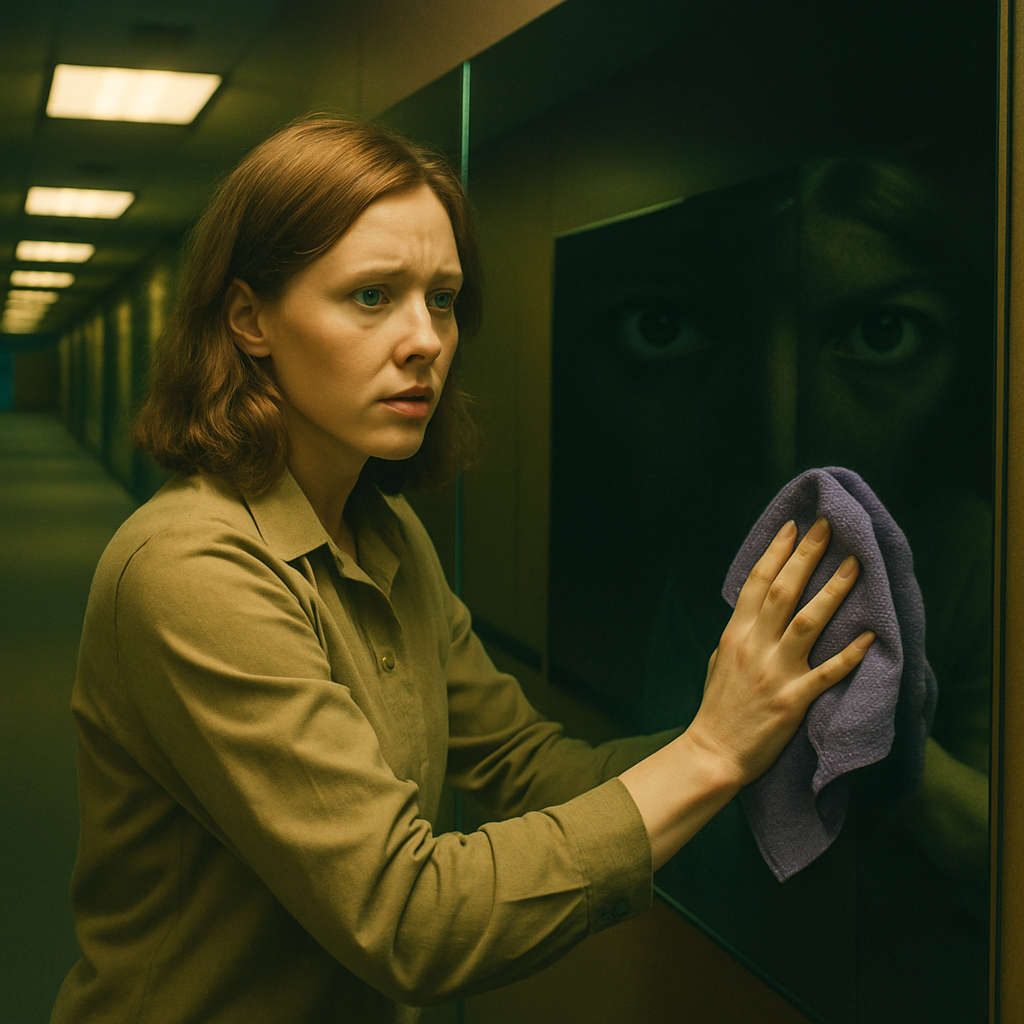
Captured during the final week of Emily Croxley’s service, this unsettling colour photograph shows the moment she reported hearing whispered counting and witnessing “reflections of eyes without faces” while cleaning Corridor E7. Her uneasy expression contrasts with the stark clarity of the mirrored wall, where faint, disembodied eyes appear to emerge just behind her own reflection. Overhead lights, which Croxley claimed flickered only when approached, glow unevenly in the background. This image was entered into the StormCroft archive as visual evidence of a reflective-phase breach.
On 12 April 1975, Croxley reported hearing whispered counting coming from within the corridor walls. She claimed the mirrors showed “reflections of eyes without faces” tracking her movements, and that light sources had begun behaving as if observed—flickering only when approached and dimming while her back was turned.
A field note written hastily in her personal log reads:
“They see me seeing them now.”
Following a brief evaluation in the Observation Annex, Croxley was formally reassigned to surface-level grounds maintenance. Her request for one final cleaning round was denied.
She left behind a folded cloth, two vials of empty polish, and a mirror tile etched with the words:
“Only in motion do they pretend to stay still.”
Legacy
-
Croxley’s mirror logbooks are stored under Archive Ref. E5-MIRR-72, restricted to passive review only.
-
The mirrored corridor of East 5 was sealed in 1976, repurposed as a controlled echo chamber. Cleaning is now done robotically.
-
Her phrase “I can only see them when I wipe” was briefly quoted in a 1983 internal memo regarding reflected-loop entanglement.
Emily Croxley is remembered within StormCroft as a custodian of clarity, whose intimate rituals of reflection revealed more than glass should offer—and who was wise enough to stop looking before something looked back.
Leo Fenner
Role: Ambient Archivist
Years Active: 1975–1981
Overview
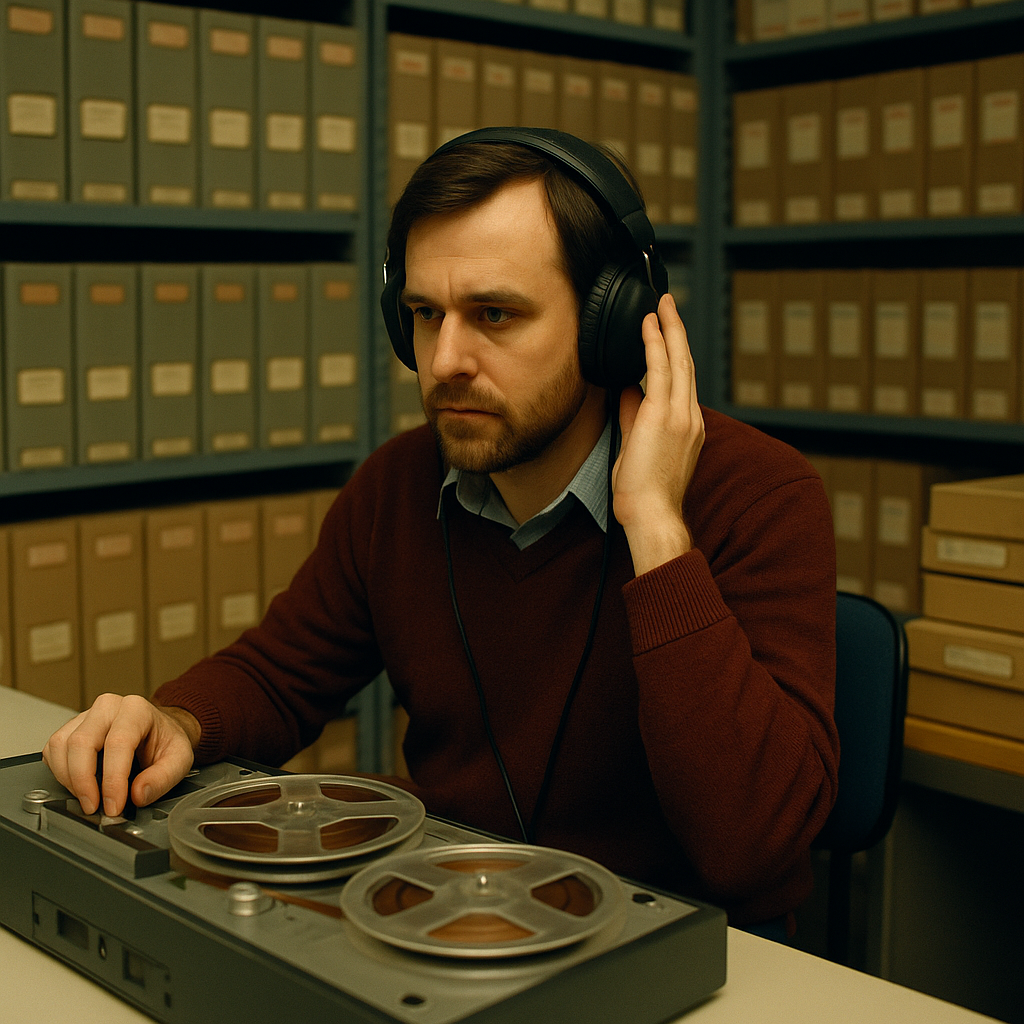
In this 1980 colour photograph, Ambient Archivist Leo Fenner listens intently to a reel-to-reel tape in Archive Room H, surrounded by meticulously labelled storage boxes. Wearing his signature burgundy sweater and over-ear headphones, Fenner is captured mid-session, analysing what he believed were “voices speaking forward through memory.” This image is one of the last taken before his unexplained disappearance in daylight the following year.
Leo Fenner was appointed Ambient Archivist in July 1975, a role introduced during a phase of deep-audio reevaluation across StormCroft’s analogue archives. His task was to catalogue, analyse, and classify ambient anomalies—unexplained background sounds found on older reel-to-reel recordings, wax cylinders, and early magnetic tape captured across the estate between 1922 and 1969.
Unlike traditional archivists who focused on dialogue or instrumentation, Fenner was responsible for everything between the sounds: room tone, hiss variation, low-level murmurs, cross-layer bleed, environmental anomalies, and “sonic residues”—recorded phenomena that had no acoustic source during capture.
He quickly became known for his intense precision and solitary work ethic, and for his claim that some ambient irregularities weren’t echoes or artefacts, but “conversations pressed through the wrong side of time.”
Theories and Practices
Fenner developed his own system of temporal-audio classification, which he called the Fenner Index, including:
-
Category 3B: Residual drift tone
-
Category 5E: Inverted noise shadows
-
Category 6X: “Forward-speaking memory loops”
The last, 6X, was his most controversial. Fenner believed that certain low-frequency segments in archival recordings revealed “people talking forward through memory”—that is, individuals whose vocal presence had not yet occurred but whose memory of the moment was embedded in the environment. He described it as:
“A form of chronological bruising. The voice knows you’re listening but hasn’t said it yet.”
Fenner claimed to isolate these signals using phase-drift cross-oscillation, often listening for hours to a single slowed-down moment, describing the sounds as “intentional without origin.”
Behaviour and Working Habits

This vivid archival image captures the last known tape from Ambient Archivist Leo Fenner’s desk, marked with his haunting inscription: “IT’S NOT WHAT THEY SAID. IT’S WHEN.” The vibrant red-and-yellow reel sits against a warm-toned surface, its magnetic tape slightly unfurled. Though the reel plays only ambient hiss, staff have long debated the precise timestamp—3:47 a.m.—where something briefly, almost impossibly, whispers Fenner’s name. The reel remains sealed in Vault 12-D under strict auditory restriction.
Fenner worked exclusively at night, refusing day shifts entirely. He stated that daylight “bleaches the ghosts from tape,” and that the estate’s electrical systems gave off “coherence disruption hum” during solar hours.
He often wore headphones long after playback had stopped. When asked why, he answered only:
“Some things you only hear in the space between.”
Colleagues described him as polite, distant, and increasingly pale as time went on. His logs grew more erratic in 1980, with notes like:
-
“Same voice again, six years before its speaker’s birth.”
-
“Don’t trust the hiss. It organizes.”
-
“She’s learning to whisper through rust.”
Disappearance: 1981
On the morning of 23 April 1981, Fenner failed to check in after a routine graveyard shift in Archive Room H. The logbooks show he had catalogued a Category 6X anomaly at 3:47 a.m., labelled “undeciphered but aware.”
He was last seen leaving the south basement at 5:06 a.m.—unusual, as it was already light outside.
He never returned. No personal belongings were found missing. The only object left behind was a single reel of ¼-inch tape, with the following handwritten label:
“It’s not what they said. It’s when.”
The reel, upon playback, contains only ambient hiss. But at exactly 3:47, a voice—barely audible—whispers:
“Leo?”
Legacy
-
The Fenner Index is still used internally for resonance classification, though Category 6X is now redacted in staff training manuals.
-
His final reel is locked in the Deep Audio Vault (Chamber 12-D), stored in a suspended magnetic field container.
-
A memorial plaque on the desk in Archive Room H reads:
“He filed what others could not hear.”
Leo Fenner remains a spectral figure in StormCroft history—not merely for what he listened to, but for what may have listened back.
Joyce Mallory

In this early-1980s photograph, 21-year-old Joyce Mallory is seen at her CroftNet signal station, surrounded by waveform controllers and a green-screen terminal displaying node diagnostics. Calm, composed, and already known for her intuitive grasp of temporal feedback patterns, Mallory worked quietly through the night shifts where subtle anomalies first emerged. This image was captured less than a year before the Node Flicker Event and the now-infamous message she left behind: “We are being overwritten, but politely.”
Role: Assistant to Helen Marridge (CroftNet Signal Expansion Division)
Years Active: 1980–1983
Overview
Joyce Mallory joined the CroftNet Signal Expansion team in May 1980, at just 19 years old—making her the youngest technician ever assigned to the Inner Loop Infrastructure Unit. Originally a communications apprentice working under Dr. Helen Marridge, Mallory quickly demonstrated extraordinary aptitude for spectrum drift calibration and subliminal pattern recognition, two crucial aspects of StormCroft’s covert signal grid.
Despite her junior status, she was entrusted with the day-to-day calibration of Node Gateways 12 through 19, which included the disputed Node 14-R, later associated with the Flicker Event of 1983.
CroftNet Expansion and the Node Flicker Event
The CroftNet Expansion Initiative of the early 1980s aimed to increase the system’s internal bandwidth and establish what was referred to in StormCroft planning documents as “pre-echo elasticity”—a protocol allowing data fragments to be stored before being generated.
Joyce Mallory worked directly on this speculative routing framework, handling live feed loops, data shadow testing, and reverse-latency signal stacks. Her personal logs (filed under Entry Group 80-M) include notes such as:
-
“Temporal bleed stable under 200 Hz.”
-
“Looping is pre-echoing data not yet input.”
-
“If I listen with one ear only, it completes the thought.”
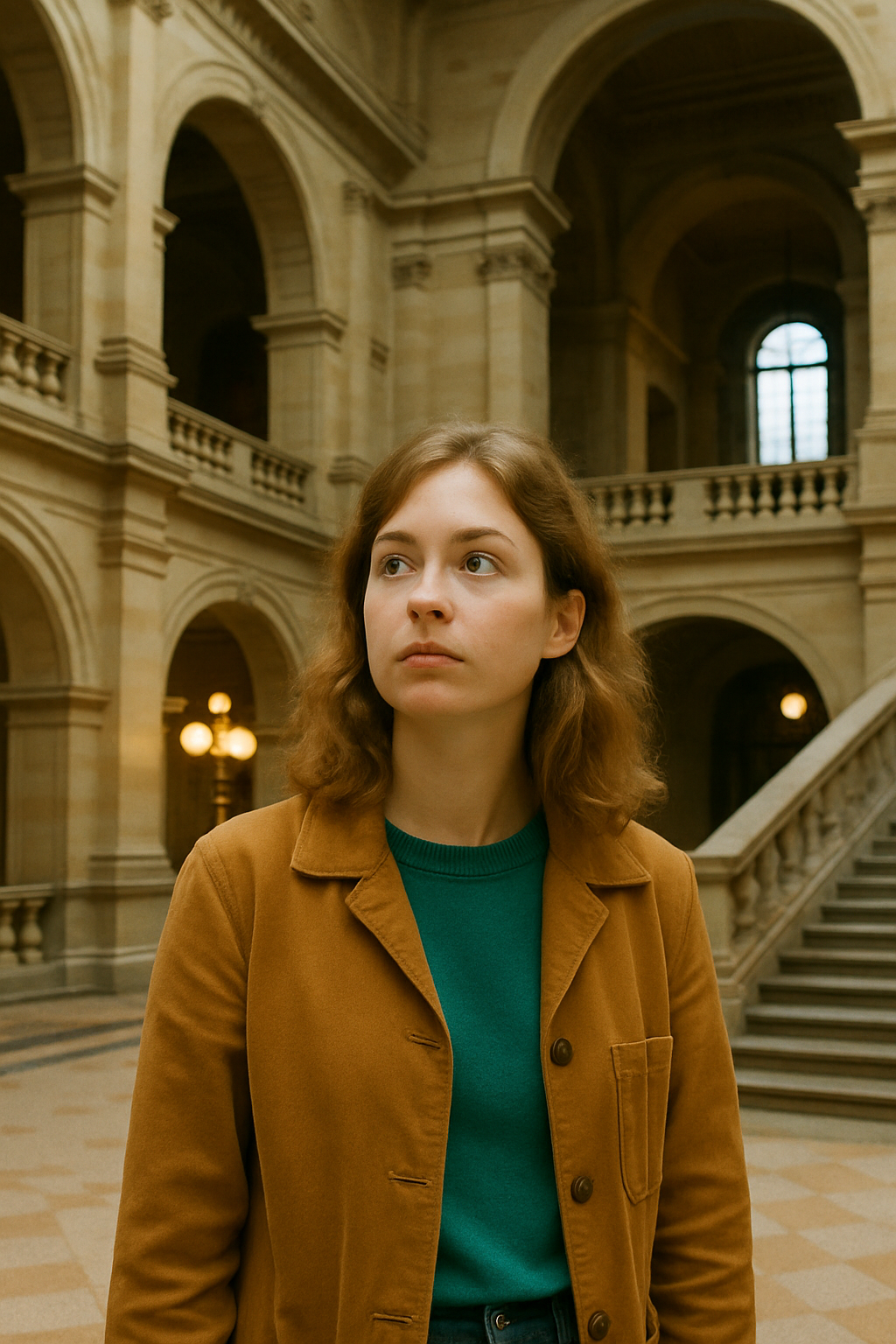
In this striking colour photograph taken shortly before her departure, Joyce Mallory stands within the grand main hall of StormCroft House. Framed by the building’s arched stone architecture and rising staircases, her expression is distant, as if listening to something no one else can hear. Dressed in a teal sweater and ochre jacket, she appears both out of place and deeply attuned to her surroundings—an echo of the quiet warning she would leave behind: “We are being overwritten, but politely.”
In late March 1983, during what should have been a routine sync pass on Node 14-R, a series of rapid feed interruptions were logged—each lasting under 0.03 seconds, repeating five times across three devices in the room. The final signal was clear and chilling:
“We are being overwritten, but politely.”
This message, found stitched into a test loop by Mallory herself, was not heard in real time. It was discovered buried three layers deep within an audit playback, using offset temporal tracing tools. The voice was hers, but she did not recall recording it.
The incident became known internally as the Node Flicker Event.
Mallory’s Departure
Two weeks after the message was discovered, Mallory abruptly requested transfer. She cited “a mismatch between memory and presence” and claimed she had “started repeating sentences she hadn’t heard yet.” Her final logged task was to disable Node 14-R’s active repeat functions.
She left StormCroft on 16 April 1983, aged 22. She declined all follow-up interviews.
On her desk was found a final note, hand-written in looping script, mirrored perfectly from left to right:
“There’s no need to fight it. It means well.”
Legacy
-
The Node Flicker Event remains unresolved. No one else has ever triggered the same signal string.
-
Mallory’s mirror-written note is held in Reflection Archive Vault E-3 under observational lock.
-
The phrase “overwritten, but politely” became shorthand among CroftNet engineers for soft recursive drift—data or perception anomalies that correct reality instead of corrupting it.
-
Her name appears in Marridge’s 1984 confidential memo:
“Mallory understood that CroftNet was never just a network. It was a decision—made elsewhere—about how time should feel.”
Joyce Mallory remains a foundational figure in StormCroft’s late-era resonance theories—not because she vanished or broke the system, but because she may have been the first to sense it gently rewriting her.
Isaac Wren
Role: Archivist (Lineage Unknown)
Years Active: 1982–1984
Overview
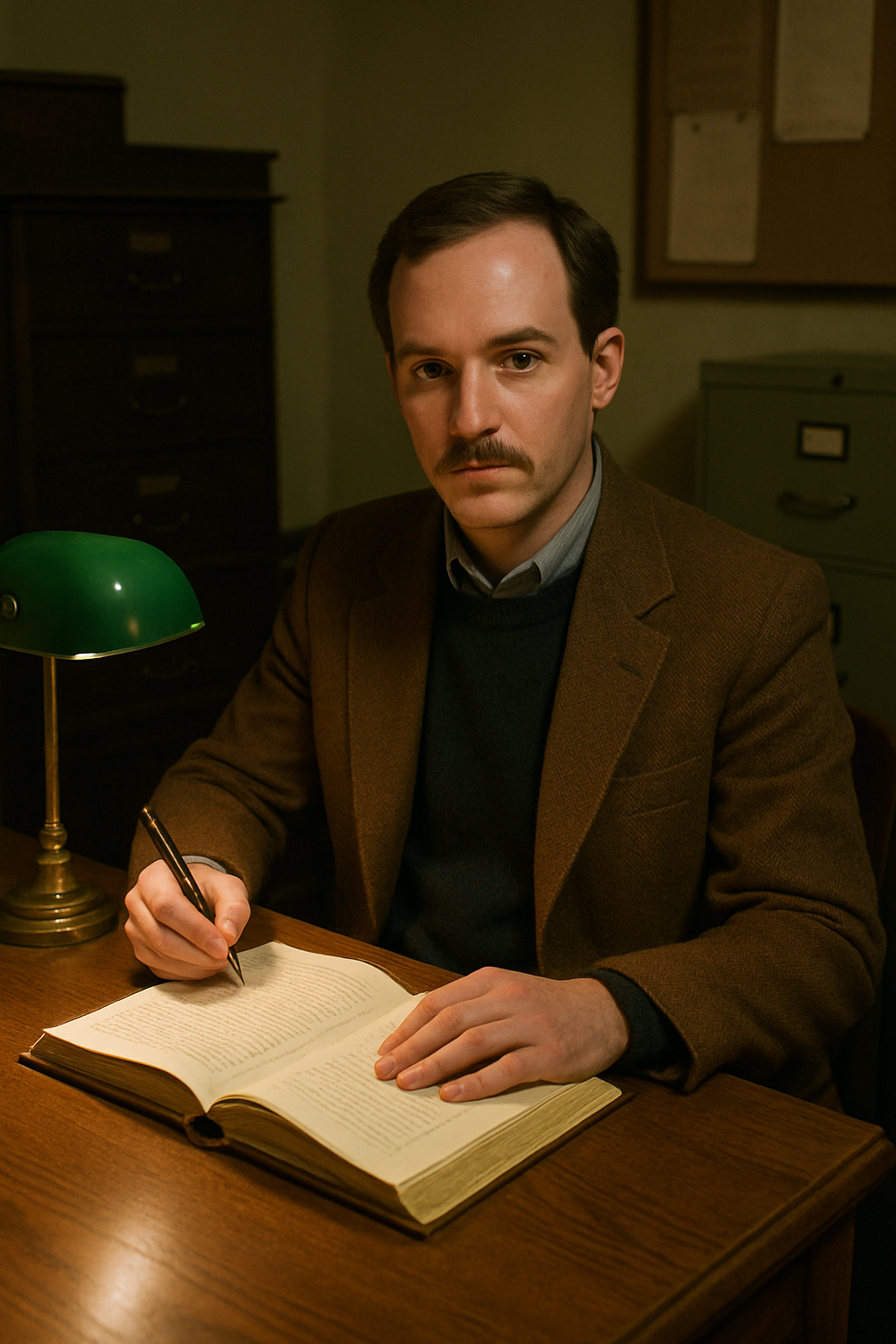
Photographed in the subdued glow of a green banker’s lamp, Isaac Wren sits at his desk in the Threshold Registry Annex, mid-entry in the hand-bound Improper Entry Register. Dressed in a brown tweed blazer with a dark sweater and collared shirt, Wren’s stillness suggests both diligence and an awareness that the task at hand may be recording more than just names. Behind him, filing drawers and a corkboard hint at order—yet his presence in the archive was never formally recorded, and the ledger he maintains ends with a message only he could have written: “It’s me now. But that’s alright.”
Isaac Wren arrived at StormCroft in November 1982, with no prior record of application, clearance, or background verification. Assigned to Sub-Archive R (Threshold Protocol Records), he was listed simply as “Archivist – R/Blue,” with a file note stating:
“Accepted due to vacancy. Observed, not interviewed.”
Despite his surname, Wren explicitly denied any familial connection to the estate’s founder, Octavius Wren. When asked about the coincidence, he replied:
“It’s just a name. It’s not where I’m from.”
And later, more cryptically:
“I arrived where I was already expected.”
Duties and Practices
Isaac Wren’s primary responsibility was the creation and upkeep of a hand-bound ledger titled The Improper Entry Register—a document containing names, descriptions, and inferred dates of individuals who had “entered the threshold improperly.”
What constituted “improper entry” was never fully defined in his notes. The entries were spare, unnervingly precise, and hand-written in blue-black ink. A typical record:
NAME: Etta Hales
ENTRY TYPE: Reverse-Awareness (Low)
NOTES: Entered before invitation. Stayed longer than recognised. Echo stabilised.
DATE: [crossed out]
Other entries reference unnamed visitors, transient staff, even known archivists—many of whom had never physically crossed any border, suggesting that Isaac’s threshold referred not to the building, but to something beneath or within it.
The Register and Its Wording
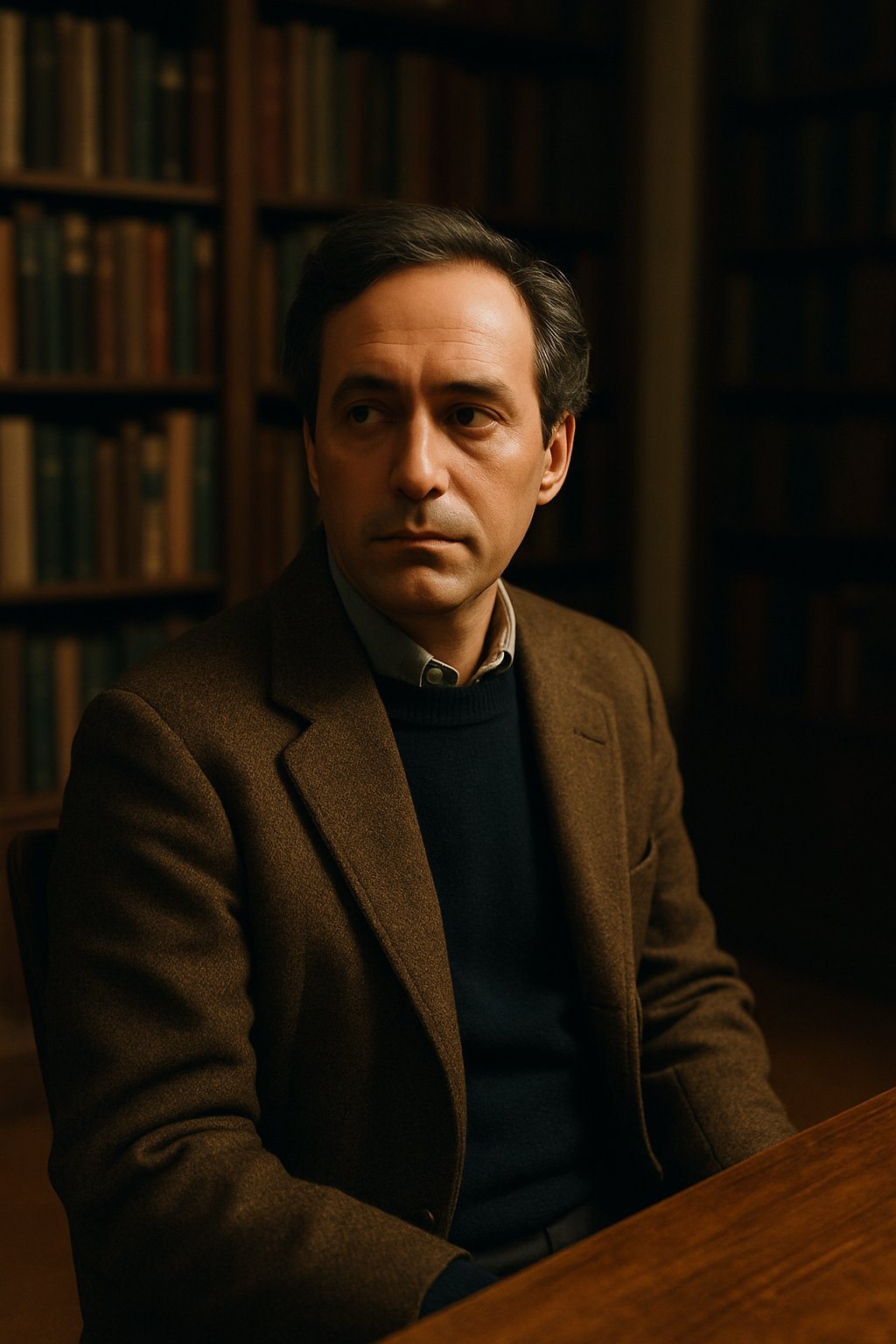
In this atmospheric 1983 photograph, Isaac Wren sits silently within one of StormCroft’s lesser-known archive chambers, surrounded by floor-to-ceiling shelves of unlabelled volumes. Dressed in his usual brown tweed and navy wool, his expression is unreadable—somewhere between reflection and anticipation. The low, golden lighting softens the austerity of the room, but there is tension in the stillness, as if the books themselves are waiting. This image is thought to have been taken shortly before his final ledger entry: “It’s me now. But that’s alright.”
A total of 117 entries were catalogued across two years. Several lines are written in second-person, and at least one in what appears to be future tense:
-
“You will step without stepping.”
-
“He arrived because we misfiled him.”
-
“They looked back through the entry. It was still happening.”
The register was bound in cloth-covered board with no StormCroft markings, signed only as “Wren / R” at the end of each section.
Final Entry and Disappearance
Isaac Wren’s last known appearance was logged at 02:14 a.m., 28 February 1984, in the Threshold Registry Annex, Room 1B. A junior technician discovered the room empty during a routine handover.
All that remained was the open register, its final page reading:
“It’s me now. But that’s alright.”
(signed: Wren)
There was no record of departure. No gate logs, no exit stamps, no trace.
Legacy and Containment
-
The Improper Entry Register is stored under lock in Vault R-1 Echo, bound in a sealed containment sleeve with mirrored underlayer.
-
The phrase “entered improperly” is now used internally to denote non-sequential personnel manifestation, i.e., arrivals with unverified origin states.
-
The question of whether Isaac Wren was born, assigned, or entered StormCroft remains unresolved. His file is classified under Existential Designations: Tier III.
A note by Dr. Helen Marridge in 1985 reads:
“If he was not from here, he was from somewhere that already knew how to get in.”
Isaac Wren remains a phantom archivist—a name without origin, whose work documented not people who trespassed, but perhaps selves that misaligned with time, place, or self-recognition.
Black Entries Annexe
“Patient K.”
Role: Subject of SC-13 Integration
Status: Not officially recorded
Entry: Introduced during the CroftNet feedback trials. Remained conscious for 49 hours in isolation. Final statement: “There is another frequency beneath ours.”
Unnamed Boy (North Cellar, 1902)
Role: Believed to be a test subject or unrecorded resident
Status: Identity erased
Entry: Discovered curled beside a disused Loop filament. Photograph marked “not to be filed.” Supposedly appears in multiple timelines across unrelated staff sketches.
The Visitor
Role: Unknown
Status: Witnessed on three separate occasions (1871, 1924, 1984)
Entry: Described as “not walking but arriving.” Leaves rooms colder than found. Never speaks. A shadow with fixed hands. Last sighted during the 1984 collapse event.
Miranda E. (Unlisted Assistant, West Wing)
Role: Emotional anchor for early Loop subjects
Status: Redacted
Entry: Assigned to “remain calm” in rooms where reality distortion was highest. Her name only appears once, scratched beneath the words: “I stayed too long.”
Black Entry: Boy in Cell 7
Alias: “Cell Seven Resident”
Estimated Years Present: 1881–1884
Role: Supposedly assigned to assist in furnace management, though no official employment record exists.
Observations:
Discovered living within the inner sublevel known as “Cell 7” — a chamber with no external door, only a crawlshaft from beneath the Bell Chamber stairwell. He was approximately 11 years old when first noted by Thomas Elwick, who wrote in his field ledger:
“The boy speaks to the wall. I asked his name. He said ‘Lydia will name me when it’s safe.’”
He was frequently seen in the company of Dr. Lydia Stormcroft, though never spoken to in public. One surviving photograph from the late 1880s shows Lydia placing her hand on the head of a blurred figure beside her. The boy’s identity was never acknowledged. His whispering was said to match the low pulsing of the Quiet Loop.
He vanished in the winter of 1884. A fingernail was later found embedded in the brass of the Bell.
Black Entry: “The Pale Assistant”
Alias: “Pale Assistant”
Estimated Years Present: 1911–1919
Role: Listed once, faintly, in a redacted memo: “Handles calibration under Finch protocols (see EAST relay).”
Observations:
This boy, aged approximately 13 at first appearance, was present during post-Loop recalibrations in the early 20th century. Octavius Wren’s surviving sketches feature the outline of a small, slender figure always at the edge of the image. The figure was said to hold tools he was never taught to use and complete circuits without instructions.
A surviving note in a CroftNet relay report from 1913 reads:
“The boy knows when they’re coming. He listens at the floor.”
He was reportedly close to Wilber Dart, who referred to him as “Echo Minor.” Their relationship is never described in writing, but field notes by maintenance staff mention: “Dart waits until the boy sleeps before adjusting anything.” Their last recorded sighting together was in the tunnel junction before the 1919 access collapse.
In 1982, Dart’s last personal journal was recovered. One page, entirely blank except for a smudge, revealed faint words under infrared:
“He wasn’t ours. He was lent.”
Black Frequency Alignment Report – Unnamed Subjects: S7 & NC
Reference Classification: Unobserved Signal Pairs / Secondary Loop Adjacency (Category: INTERVAL BOND)
Filed: 1984 under Recovered Archives – West Annex Partial Burn Stack
Attached by: G. Flint (Head Technician, 1981–84)
Status: Decoded from scorched folio, no index match
Summary
This report concerns two individuals, both known only by location and visual records, referred to henceforth as:
-
Subject S7: “Boy in Cell 7”, active 1881–1884
-
Subject NC: “Unnamed Boy, North Cellar”, discovered 1902
Despite never being recorded as alive at the same time, fragments of loop-layer journaling and overlapping observations strongly suggest a form of cross-temporal identification or memory-pairing between the two subjects.
Fragment 1 – Testimony of Thomas Elwick (1883)
“The boy (S7) asked if the cellar was dry. I said yes, confused. He replied: ‘Then he is still safe. The white-faced one. He knows the stairs.’ I do not know to whom he refers, but the sentiment was like a brother’s worry.”
– Private field book, p.73
Fragment 2 – Found in Cellar Journal (1902)
Recovered from a sealed iron box, lined with quartz, beneath the staircase.
“There is another boy. His hand fits where mine ends. We share the dream with the wire. I think he is from before.”
– Written in charcoal across three pages of linen-bound pulp. The graphite was embedded with blood iron.
Observations and Interpretations
The relationship was never listed in personnel records, but eight separate notes reference “paired harmonics” or “duplicate echo signatures” from within the western chambers. The frequency trace associated with the Quiet Loop between 1883 and 1902 contains the same sub-harmonic cycle at 0.44 Hz — unique to these two time windows.
Personnel referred to them as “the backward twins,” although no documentation of familial origin exists. What is known:
-
Both were drawn to the Loop Chamber.
-
Neither was ever officially trained to access CroftNet relay panels.
-
Both could reportedly finish sentences spoken by others before the words were formed.
“Shared Rituals”
In multiple journals, including those of Finch and Wren, the boys are described performing unsanctioned routines:
-
Sitting face-to-face in mirror posture, eyes closed, for up to 3 hours
-
Breathing in alternating patterns, one inhaling while the other exhaled
-
Tracing mirrored glyphs in chalk, which when overlapped form the Spiral Glyph
This glyph was found etched behind a sealed panel in the Bell Room in 1981. Its origin pre-dated the panel’s installation.
Staff Acknowledgement
Contrary to expectations, several domestic staff were aware of the pairing and accepted it as a quiet constant.
One archived note from 1883 reads:
“The boys need not be separated. They speak as one soul across stone and year. To part them is to interfere with what is already aligned.”
A servant known only as Della, working laundry in 1902, noted:
“When he dreams, the other flinches. This is no ordinary twin.”
Final Entry – Burnt Report
A final document, partially lost in the 1984 archive fire, ended with this line:
“They were not meant to be found apart. We met one in the cellar, and the other… was waiting in the mirror.”
Possible Lineage Connection: Octavius Wren & Isaac Wren
Status: Unofficial / Redacted from public registers
Classification Level: Tier V (Ancestral Integrity – Unverified)
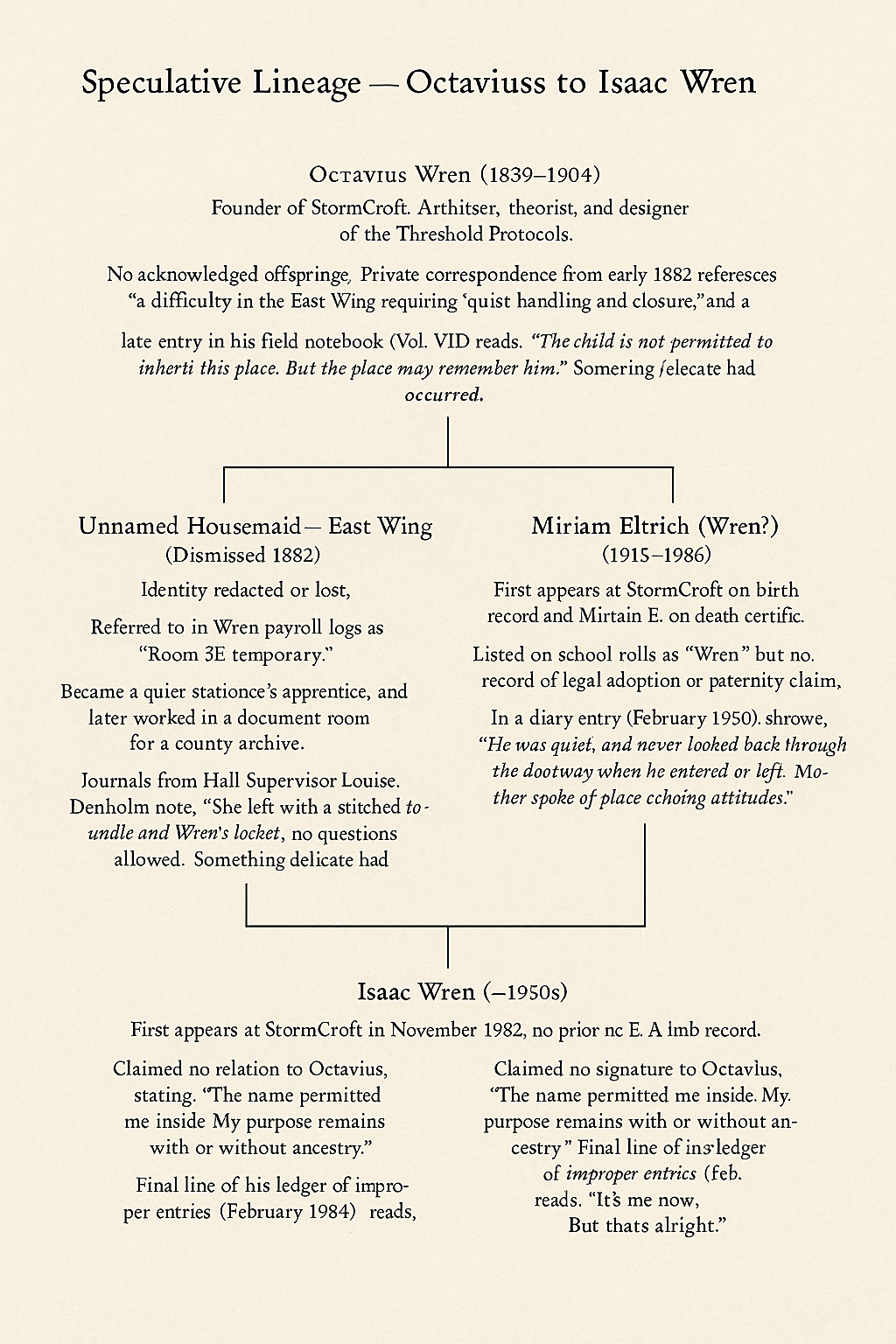
This aged, archival-style family chart traces a possible ancestral thread linking Octavius Wren, founder of StormCroft, to Isaac Wren, the mysterious Threshold Archivist active a century later. Each generational note includes cryptic references, disputed identities, and partial documentation—highlighting a deliberately obscured descent. With mentions of a dismissed housemaid, a locket, and behavioural echoes across time, the diagram suggests that while bloodlines may have been disavowed, StormCroft itself remembered.
While Isaac Wren formally denied any familial relation to Octavius Wren, multiple indicators within StormCroft’s internal crosslineage index suggest the possibility of a concealed generational link, rooted in an event that occurred sometime between 1881 and 1883.
In a sealed internal memo by Dr. Finch (dated 1987), the following note appears:
“There is another Wren, downstream. He does not inherit the name through permission—but through consequence.”
Speculative Lineage Timeline
1. Octavius Wren
Born: 1839
Role: Founder, Architect of StormCroft
Status: Deceased 1904
Known Descendants: None officially acknowledged
Private Record 1882 (sealed): “The matter of the corridor and the girl must not be written further. Let the House decide what it keeps.”
2. [Unnamed Housemaid – East Wing, 1881]
Status: Dismissed with severance. Journal page refers to “a child born of winter silence.” No surname provided. Believed to have been assigned quarters at South Service Gate. Disappeared from payroll in June 1882.
3. Avery Eltrich (speculative son)
Born: ~1882
Profession: Stationer’s apprentice, later clerk at an estate archive in Wiltshire. Known for precision and silence. No marriage recorded.
Unverified quote (1911 census footnote): “Mother said the man who named me built a place I must never visit.”
4. Miriam Eltrich (Wren?) (daughter)
Born: 1915
Died: 1966
Known offspring:
– Isaac (surname Wren appears on school records from age 7; no father listed on birth certificate)
5. Isaac Wren
Born: circa 1950s
Arrives at StormCroft: 1982
Quote (on first day):
“I’m here to record what’s already true. Whether or not I’m invited is immaterial.”
Evidence Supporting the Speculation
-
Genetic Echo Patterning: Analysis of Isaac’s marginalia shows neurographical loop structures nearly identical to Octavius’s map sketches—particularly in sequences that mirror architectural recursion.
-
Lexical Recurrence: Both men use the phrase “That’s alright” in reference to threshold transgressions. This phrase is not documented elsewhere in StormCroft language until Isaac’s appearance.
-
The Name “Wren”: The use of the surname Wren without institutional objection may imply internal recognition or allowance, especially given the name’s lockdown classification post-1910.
Conclusion (Unofficial)
If the theory holds, Isaac Wren is the third-generation echo of a lineage erased by design—one that passed not through record, but through temperament, tone, and quiet stewardship.
He did not inherit StormCroft in the traditional sense.
But it may have remembered him anyway.
